Utah Documents
Quitclaim Deed
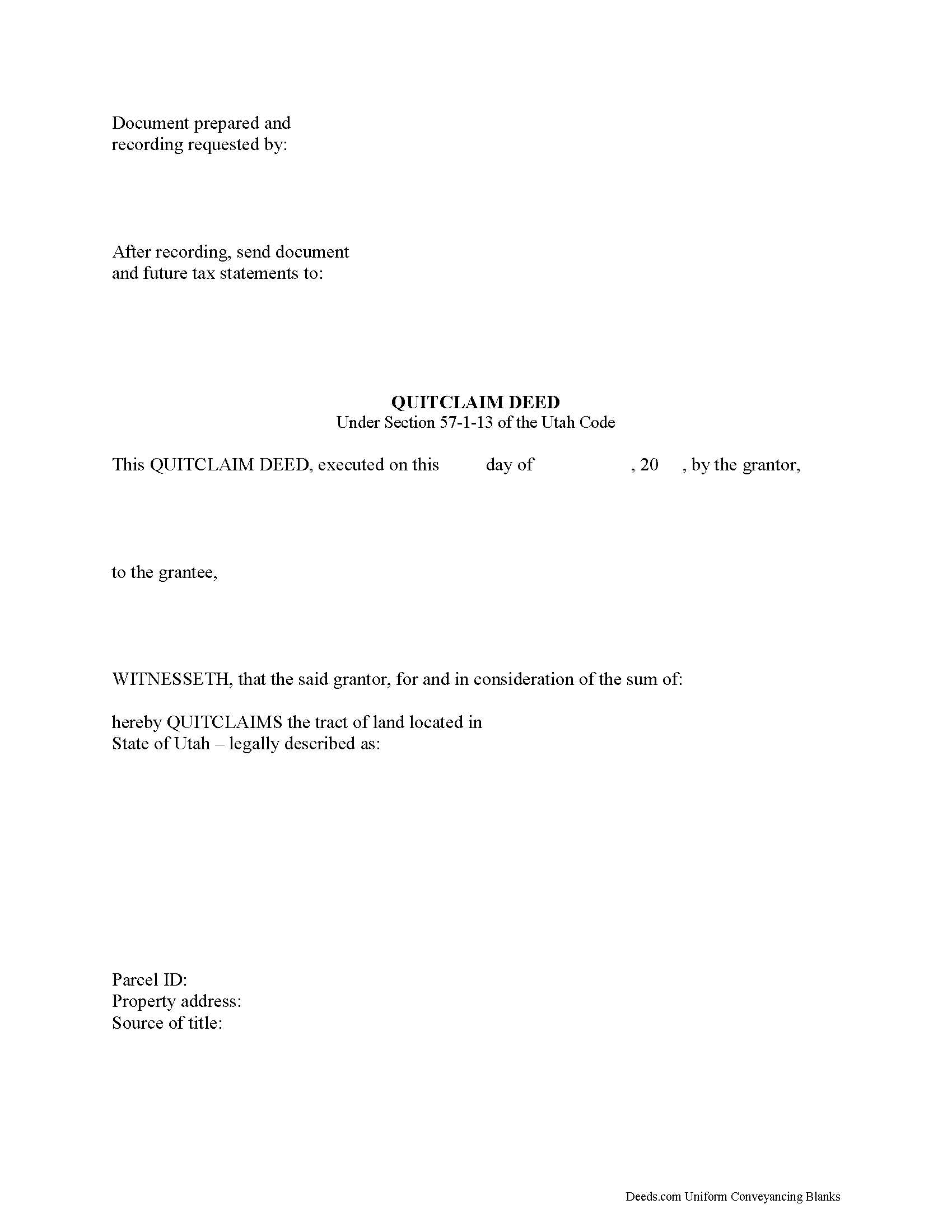
A quitclaim deed executed in Utah must be signed by each grantor involved in the conveyance. A certificate of acknowledgment, proof of execution, jurat, or other certificate may be required in order to effectively record a quitclaim deed with a county recorder. A quitclaim deed may not be presented to an appropriate county recorder in Utah unless it contains a legal description of the real property, names the grantee, and recites a mailing address for assessment and taxation. Additional requirements may apply to a Utah quitclaim deed. For a thorough discussion, visit the county links, or go to the Utah Revised Code.
When a quitclaim deed is recorded in the county where the property is located, notice of its contents is imparted to all persons (57-3-102). The recording act in Utah stipulates that if a quitclaim deed is left unrecorded, it is void against subsequent purchasers of the same real property or any portion of it if (1) the subsequent purchaser bought the property in good faith and for valuable consideration and (2) the subsequent purchaser's document is recorded first.
(Utah QD Package includes form, guidelines, and completed example)... More Information about the Utah Quitclaim Deed
Gift Deed
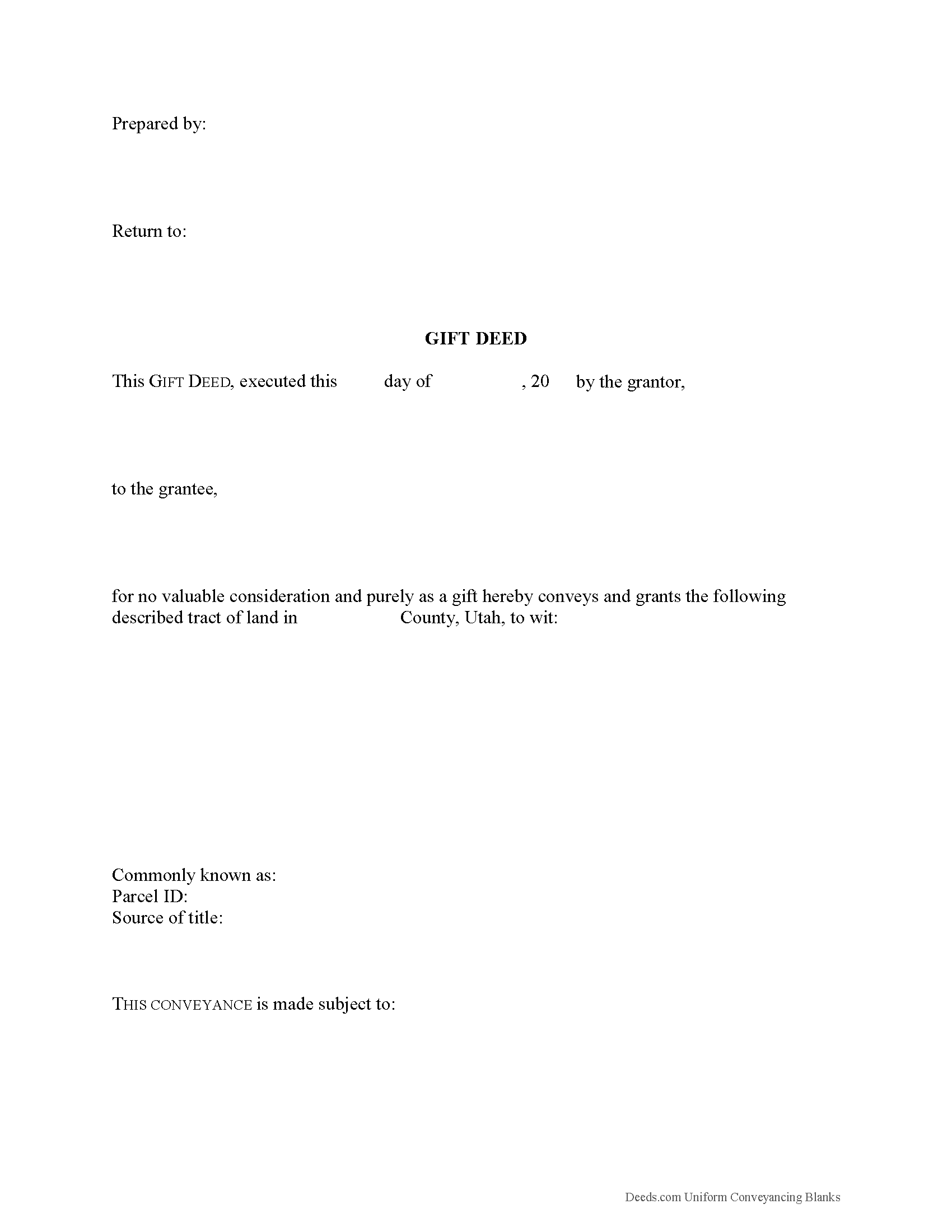
A gift deed, or deed of gift, is a legal document voluntarily transferring title to real property from one party (the grantor or donor) to another (the grantee or donee). A gift deed typically transfers real property between family or close friends. Gift deeds are also used to donate to a non-profit organization or charity. The deed serves as proof that the transfer is indeed a gift and without consideration (any conditions or form of compensation).
Valid deeds must meet the following requirements: The grantor must intend to make a present gift of the property, the grantor must deliver the property to the grantee, and the grantee must accept the gift. A gift deed must contain language that explicitly states no consideration is expected or required, because any ambiguity or reference to consideration can make the deed contestable in court. A promise to transfer ownership in the future is not a gift, and any deed that does not immediately transfer the interest in the property, or meet any of the aforementioned requirements, can be revoked [1].
A lawful gift deed includes the grantor's full name and marital status, as well as the grantee's full name, marital status, mailing add... More Information about the Utah Gift Deed
Transfer on Death Deed
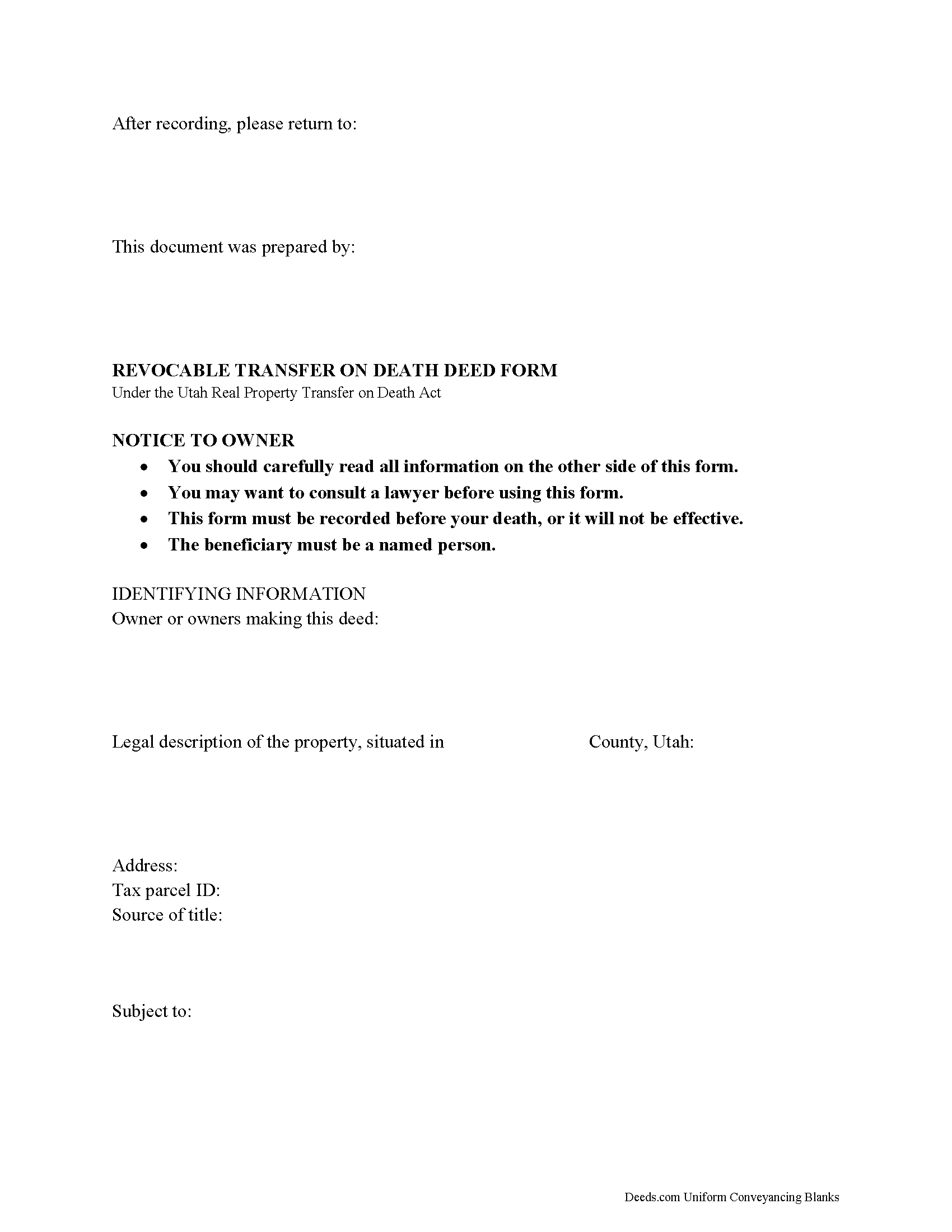
Utah code 75-6-405. Transfer on death deed authorized.
(1) An individual may transfer property to one or more named beneficiaries effective at the transferor's death by a transfer on death deed.
Use this form to transfer real estate at death, but outside of a will and without the need for probate distribution. Execute the TODD form, then record it during the course of your life.
75-6-409. Requirements.
A transfer on death deed shall:
(1) contain the essential elements and formalities of a properly recordable inter vivos deed;
(2) state that the transfer to the designated beneficiary is to occur at the transferor's death; and
(3) be recorded before the transferor's death in the public records in the county recorder's office of the county where the property is located.
Overall, the Simple Revocable Transfer on Death Deed offers a convenient, flexible option to consider as part of an overall estate plan. Even so, they may not be appropriate in all cases. Contact an attorney for complex situations or with any questions.
(Utah TODD Package includes form, guidelines, and completed example)... More Information about the Utah Transfer on Death Deed
Warranty Deed
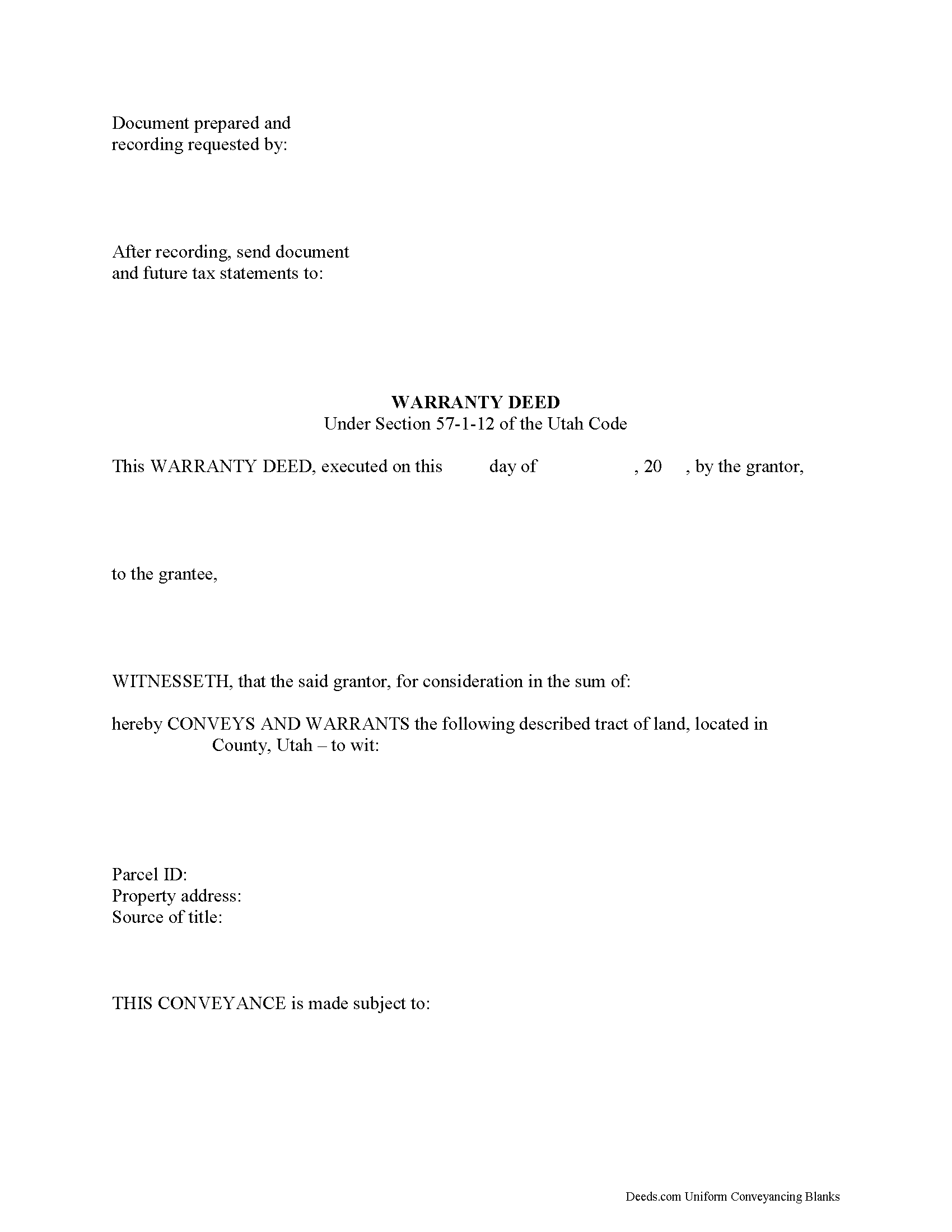
A warranty deed can be used to transfer title to real property in Utah. The statutory form for a warranty deed is provided in 57-1-12 of the Utah Revised Code. A warranty deed, when duly executed, will have the effect of a conveyance in fee simple to the grantee, the grantee's heirs, and assigns of the premises named in the warranty deed, and of all appurtenances, rights, and privileges belonging to the premises named in the deed. The grantor in a warranty deed covenants that (a) he lawfully owns fee simple title to and has the right to immediate possession of the premises being conveyed; (b) the grantor has good right to convey the premises; (c) the grantor guarantees the grantee, the grantee's heirs and assigns in the quiet possession of the premises; (d) the premises are free from all encumbrances; and (e) the grantor, the grantor's heirs, and personal representatives will forever warrant and defend the title of the premises in the grantee, the grantee's heirs, and assigns against all lawful claims (57-1-12). If there are exceptions to any of these covenants, they can be inserted into the deed after the legal description of the property. A warranty deed is customarily used in r... More Information about the Utah Warranty Deed
Special Warranty Deed
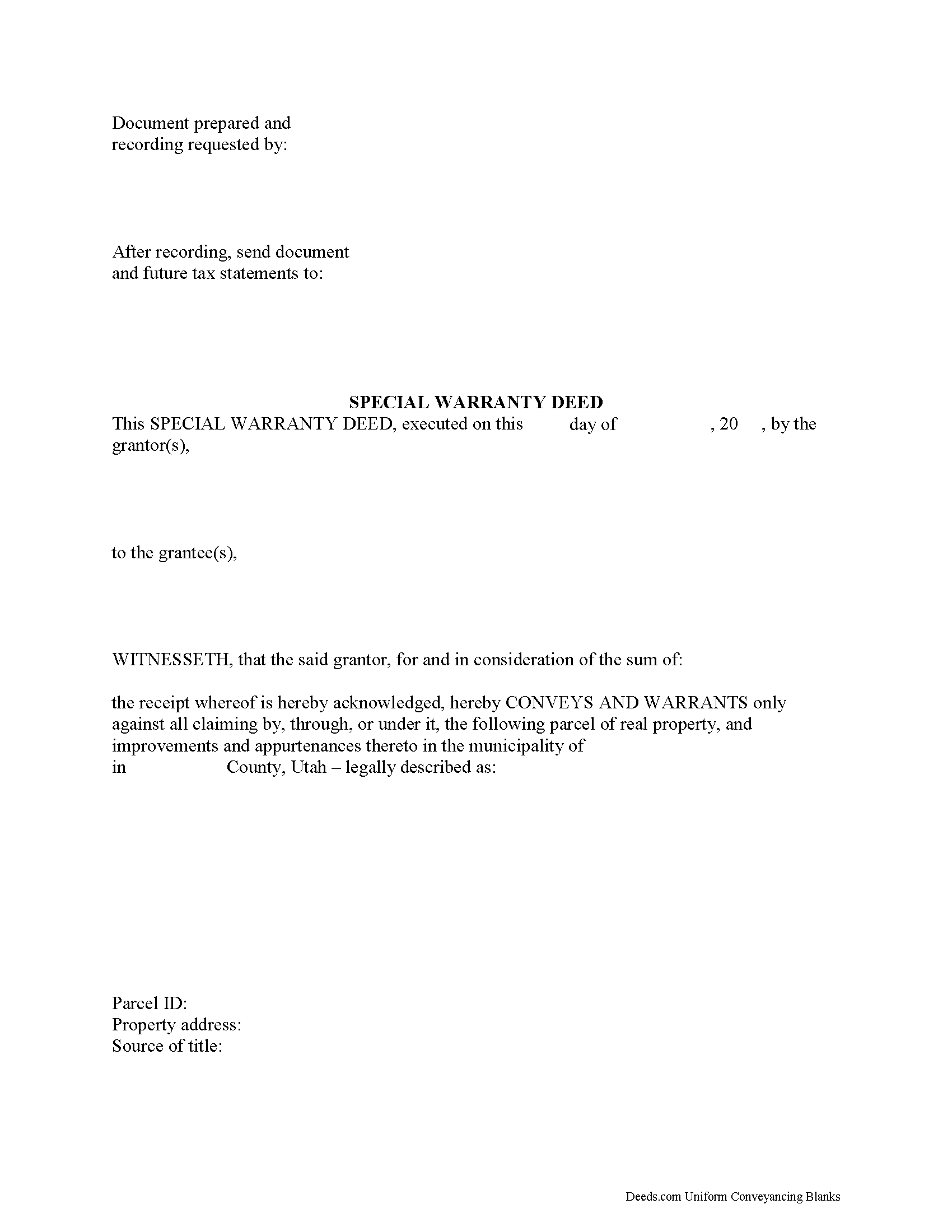
A special warranty deed can be used in Utah to convey title to real property. A duly executed special warranty deed will have the effect of a conveyance in fee simple to the grantee, the grantee's heirs, and assigns of the property named in the special warranty deed, with all the appurtenances, rights, and privileges belonging to the granted property. A special warranty deed in Utah contains covenants from the grantor that (a) the granted property is free from all encumbrances made by the grantor, and (b) the grantor, the grantor's heirs, and personal representatives will forever warrant and defend the title of the property in the grantee, the grantee's heirs, and assigns against any lawful claim and demand of the grantor and any person claiming or to claim by, through, or under the grantor. Any exceptions to the special warranty covenants can be briefly inserted in the deed after the description of the land (57-1-12.5). A special warranty deed offers less protection to the buyer than a general warranty deed.
A special warranty deed must be signed by the grantor and notarized or proved in order to be eligible for recording by a county recorder in Utah. Notarial acts in this sta... More Information about the Utah Special Warranty Deed
Grant Deed
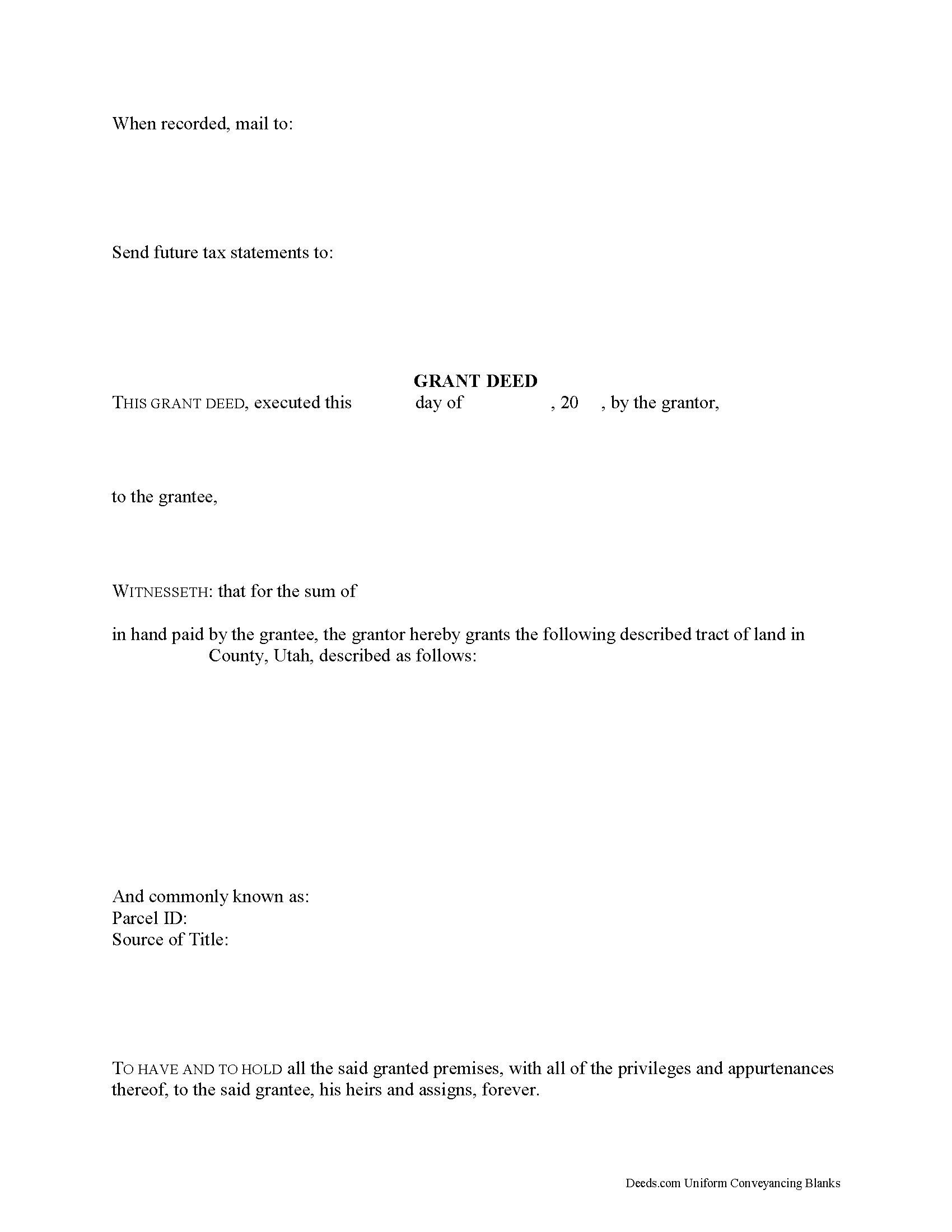
In Utah, title to real property can be transferred from one party to another by executing a grant deed. Use a grant deed to transfer a fee simple interest with some covenants of title. The word "grant" in the conveyancing clause typically signifies a grant deed, but it is not a statutory form in Utah.
Grant deeds offer more protection for the purchaser (grantee) than quitclaim deeds, but less than warranty deeds. A grant deed differs from a quitclaim deed in that the latter offers no warranty of title, and only conveys any interest that the grantor may have in the subject estate. Grant deeds guarantee through implied covenants that the title is free of any encumbrances (except for those stated in the deed) and that the grantor holds an interest in the property and is free to convey it. A warranty deed offers more surety than a grant deed because it requires the grantor to defend against claims to the title.
A lawful grant deed includes the grantor's full name, mailing address, and marital status; the consideration given for the transfer; and the grantee's full name, mailing address, marital status, and vesting. Vesting describes how the grantee holds title to the property. Ge... More Information about the Utah Grant Deed
Correction Deed
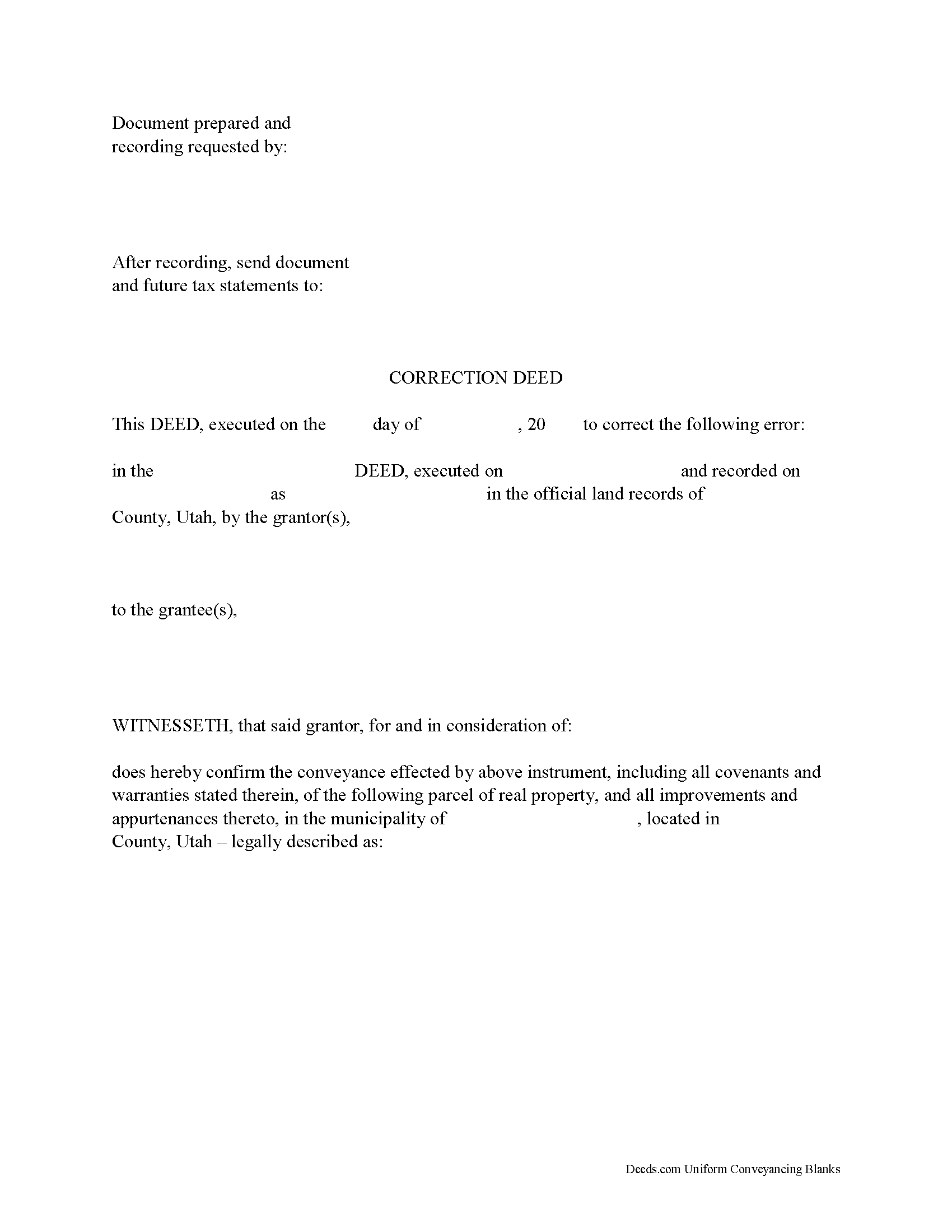
Use the corrective deed to amend a previously recorded deed of conveyance with an error that could affect title.
An error in a document can be corrected in one of three ways in Utah: by recording an affidavit, by re-recording the original document, and by recording a new document. An affidavit can only be effective if it clarifies an ambiguity created in the original deed. It cannot add to or take away from the effect of the original recording. There are different types of affidavits, each used to correct different issues in a document.
For typographical errors, use a scrivener's affidavit. As far as correcting the legal description, omissions or obvious typographical errors that will not allow a point of beginning to be determined can be corrected by a scrivener's affidavit. However, if a point of beginning can be determined on the original document, whether or not it was the one intended by the executor of the document, an affidavit cannot change the point of beginning.
Another error in the legal description that can be corrected with an affidavit is the omission of a plat of a recorded subdivision, but the omission of the section, township, or range from the descripti... More Information about the Utah Correction Deed
Easement Deed
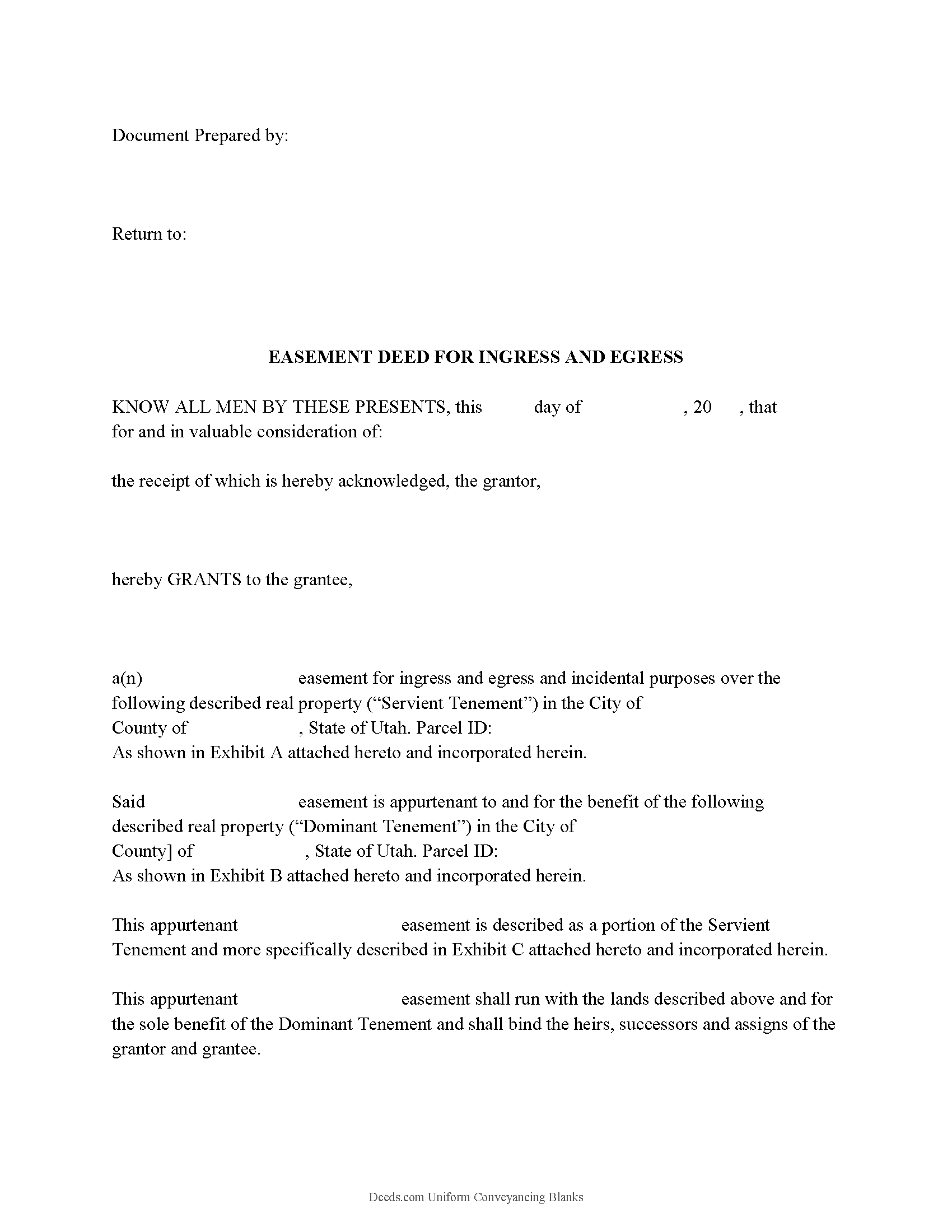
An easement is a non-possessory interest in land that allows an easement holder to use another's real property for a specific purpose. Easements can be either appurtenant or in gross. An easement deed is the instrument that creates the rights contained in an easement, and should therefore specify the scope and duration of the easement. A solar easement is statutorily defined as a right, whether or not it is stated in the form of a restriction, easement, covenant, or condition, in any deed, will, or other instrument executed by or on behalf of any owner of land or solar skyspace for the purpose of ensuring adequate exposure of a solar energy system (57-13-1). An easement of this type is required to be in writing. Prescriptive easements of different types, such as an easement for a livestock trail, can also be established in Utah.
In order for an easement deed to be considered for recordation by a county recorder in Utah, it must be signed and acknowledged by the grantor and accompanied by a certificate of acknowledgment or proof of execution that is signed by the officer taking the acknowledgment (57-3-101). The proof of execution of an easement deed can also be made by a subscr... More Information about the Utah Easement Deed
Termination of Easement
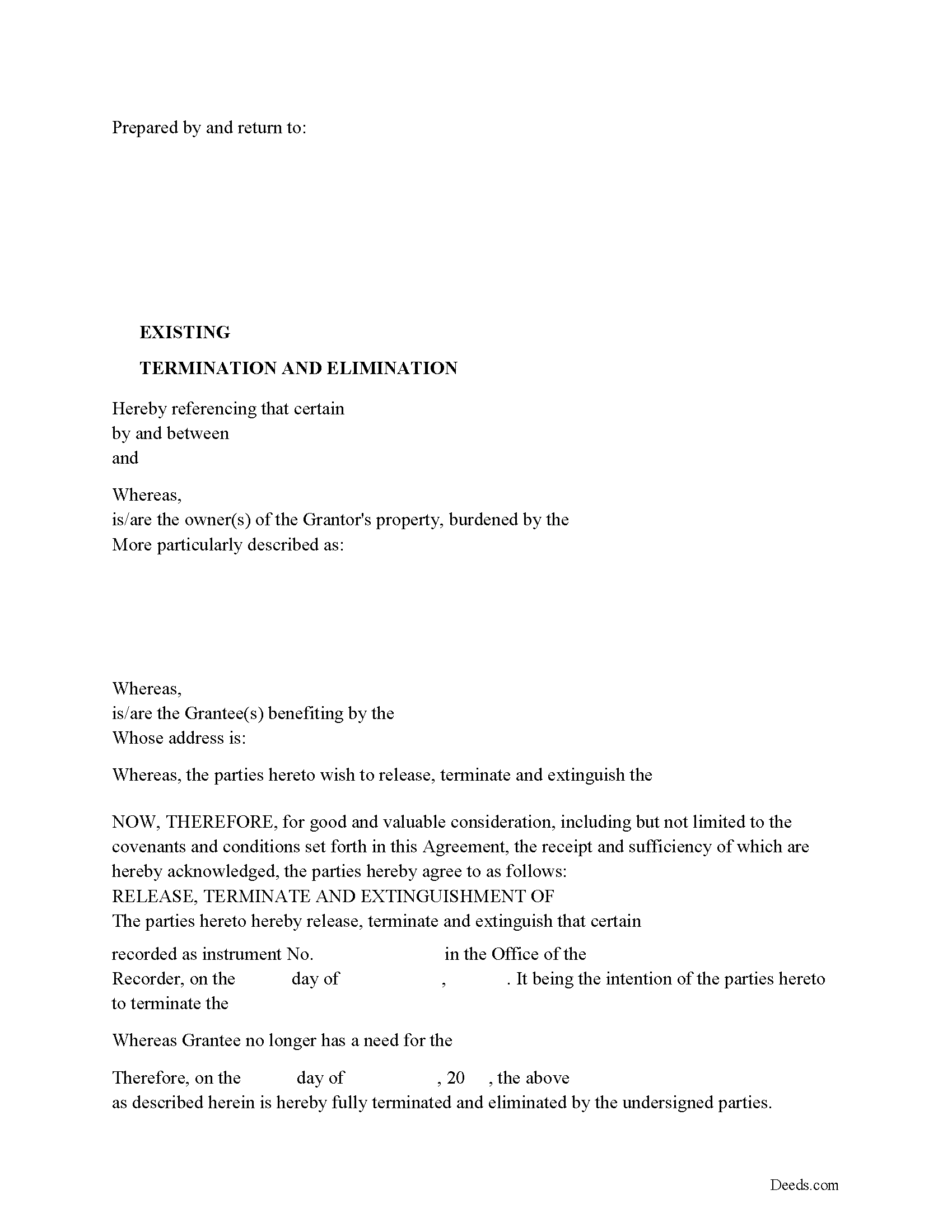
Use this form to release, terminate, extinguish a previously recorded document that involves access to and from a property.
Documents such as:
1. Easement Deeds or Agreements (An easement is a non-possessory interest in land, granting the right to use someone else's property for a specific purpose, like a driveway or utility line)
2. Access Roads
3. Right of Ways
4. Utility Easements (Power, Gas, Water, Sewer, Etc.)
5. Drainage Easements
This document allows the owner of the land, burdened by the access and the party that benefits from the access, to sign an agreement releasing the property from such access, ... More Information about the Utah Termination of Easement
Personal Representative Deed
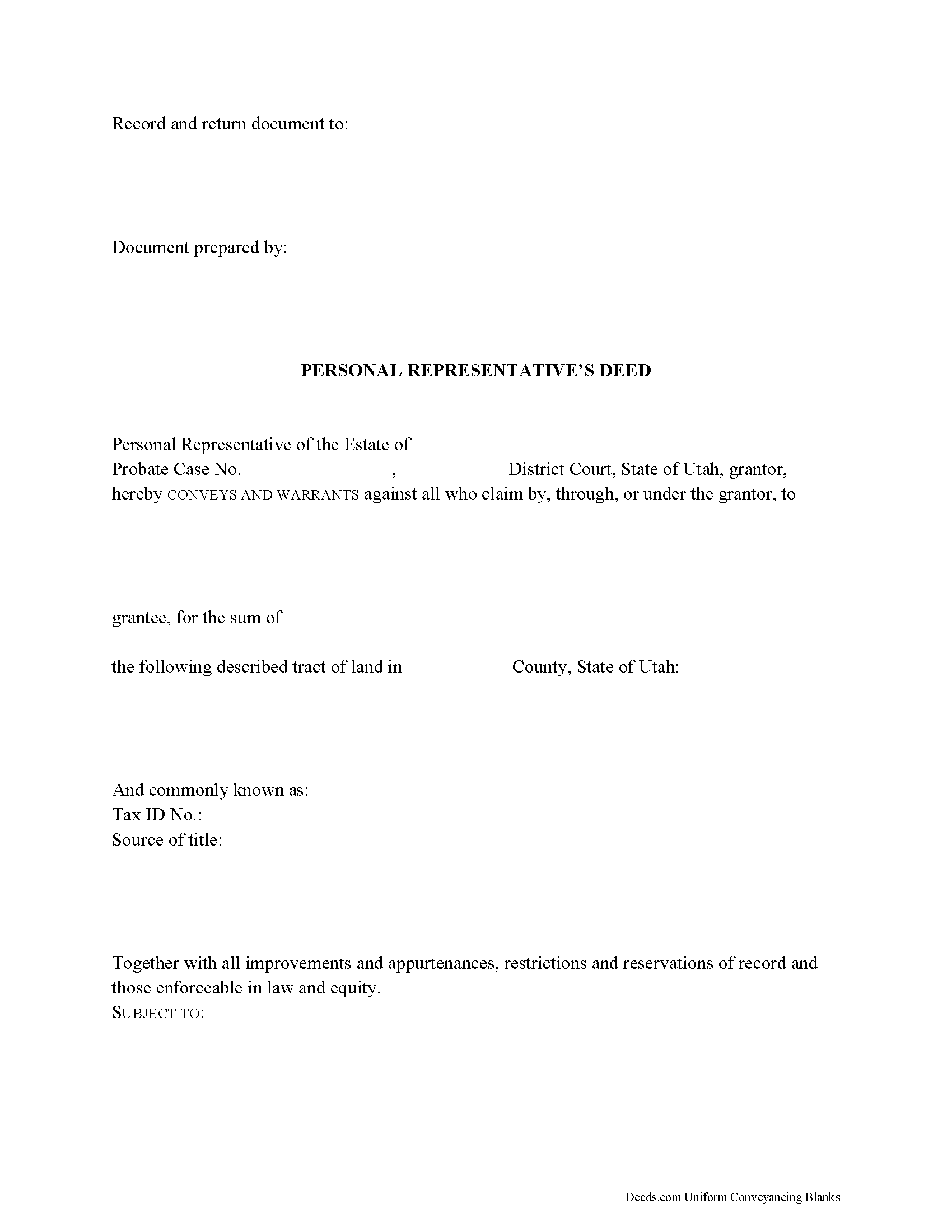
A personal representative's deed is a fiduciary instrument used in probate proceedings. Probate is the process of settling and distributing a decedent's estate. The Utah Uniform Probate Code is codified at Title 75 of the Utah Code.
Executed by a personal representative (PR), the PR deed transfers fee simple title to a purchaser following a sale of real property from an estate.
When assets are insufficient to pay creditors' claims, the PR may be required to sell assets from the estate. Transactions that the PR is authorized to enter are outlined in 75-3-714, and include the sale of real property. To transfer title following a sale of real property, the PR executes a deed. A personal representative's deed is named after the executing officer, but typically carries the same covenants as a special warranty deed.
A special warranty deed is a statutory form under 57-1-12.5. By including the specific language that the grantor "conveys and warrants against all who claim by, through, or under the grantor," the PR covenants with the purchaser (grantee) that the property is free from encumbrances made by the grantor and that the grantor will defend the grantee's title against vali... More Information about the Utah Personal Representative Deed
Deed of Distribution
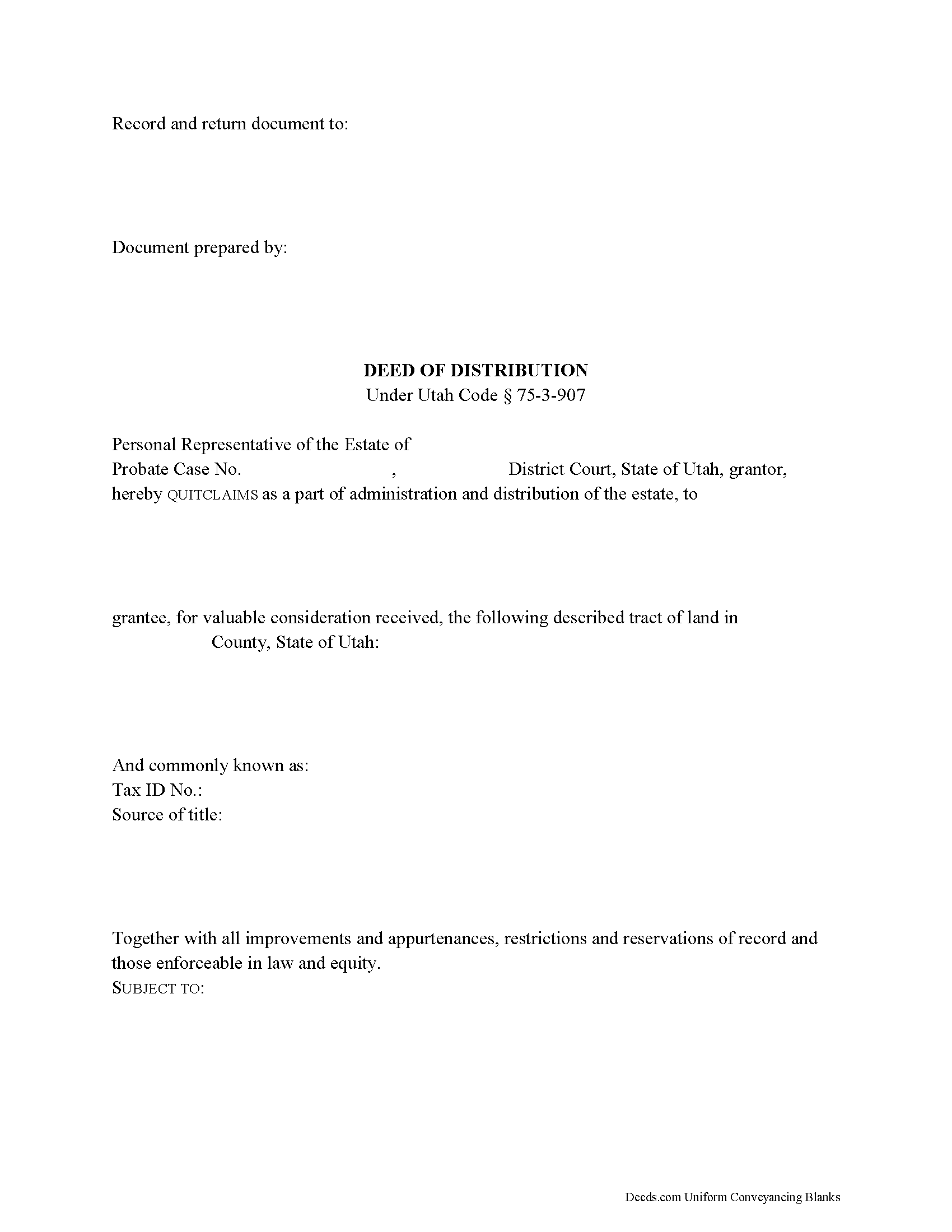
A deed of distribution is a legal instrument of conveyance recorded as part of probate proceedings. Probate is the process of settling and distributing a decedent's estate. The Utah Uniform Probate Code is codified at Title 75 of the Utah Code.
Following the payment of claims against the estate, the personal representative (PR) may execute a deed of distribution under 75-3-907 to transfer fee simple title to real property to the distributee of an estate. A recorded deed of distribution is "conclusive evidence that the distributee has succeeded to the interest" in the property "as against all persons interested in the estate" (75-3-908). The deed releases the PR's power over the property and establishes marketable title. The instrument is functionally equivalent to a quitclaim deed and carries no warranties.
Deeds of distribution name the personal representative as the granting party, reference the decedent by name, and cite information about the probated estate, including the district court in which probate is opened and the case number assigned to the estate. To properly transfer title, include the grantee's full name, mailing address, and vesting information. All documents ... More Information about the Utah Deed of Distribution
Affidavit of Surviving Joint Tenant
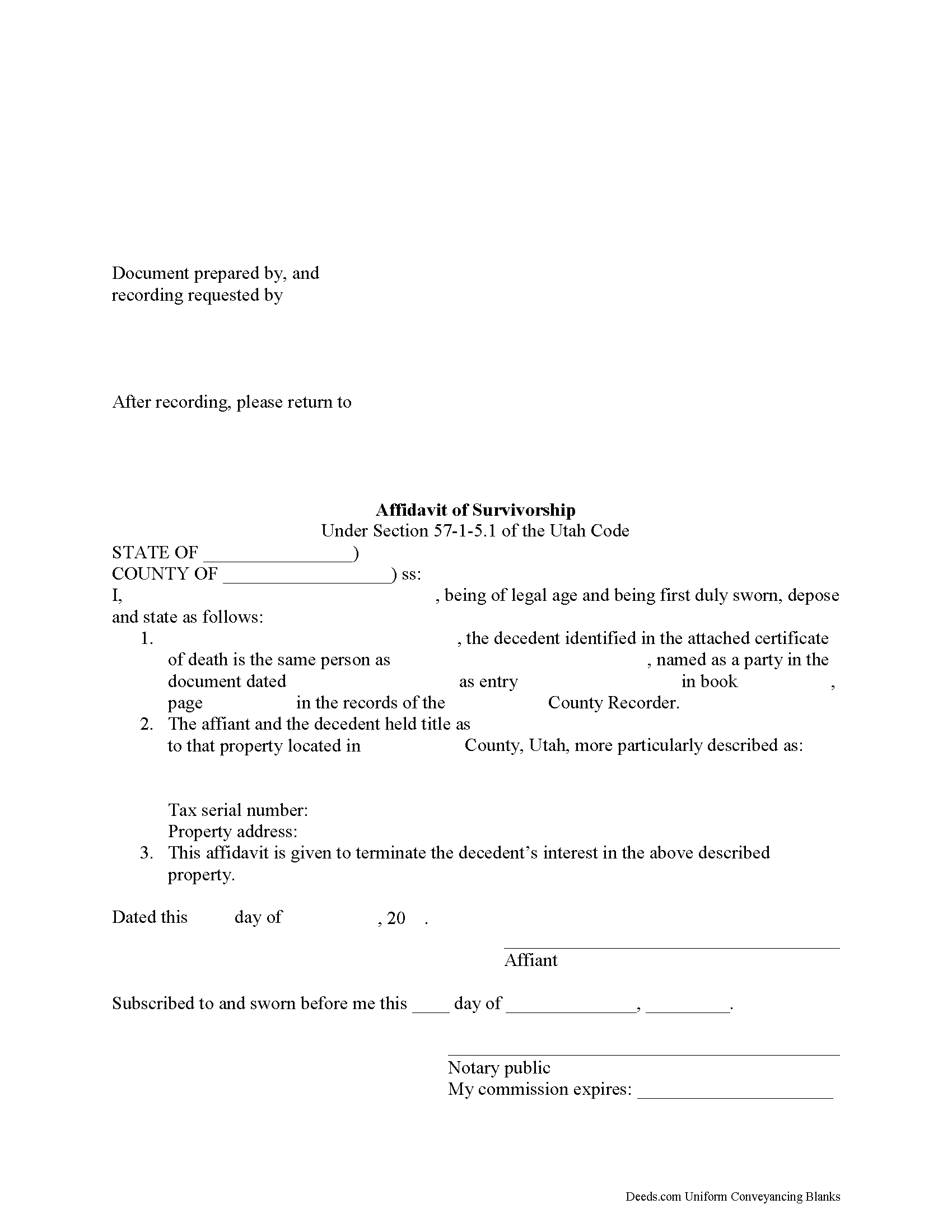
Transferring Title with the Utah Affidavit of Survivorship
Utah's affidavit of survivorship is governed by Section 57-1-5.1 of the Utah code. When lawfully executed and recorded, this document passes title of property held as joint tenants to the survivor(s) after the death of one of them.
Under 57-1-5.1, the affidavit must contain specific information: it must cite the interest being terminated; contain a legal description of the property; refer to the recording information of the deed creating the interest; include an official copy of the deceased owner's death certificate; and be recorded in the recorder's office for the county where the property is located.
This document is important because it helps to maintain a clear chain of title (ownership history) for the property, which should, in turn, help to simplify future transactions. Each circumstance is unique, so contact an attorney with specific questions or for complex situations.
(Utah AOSJT Package includes form, guidelines, and completed example)... More Information about the Utah Affidavit of Surviving Joint Tenant
Deed of Trust and Promissory Note
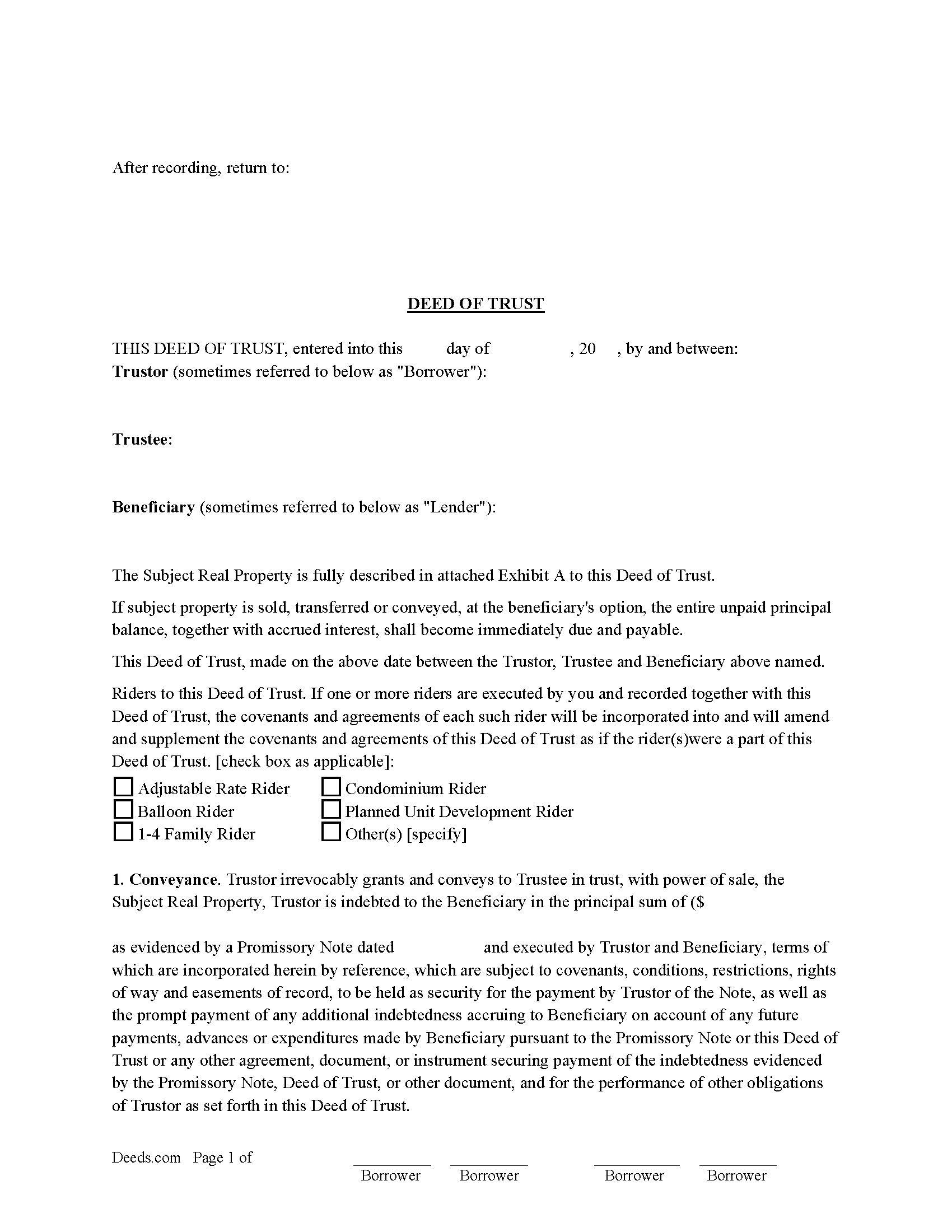
A deed of trust (DOT), is a document that conveys title to real property to a trustee as security for a loan until the Trustor/borrower repays the Beneficiary/lender according to terms defined in an attached promissory note. In Utah a Deed of Trust with "Power of Sale" is the most favored lending instrument, foreclosures can be non-judicially, saving time and expense.
There are Three parties in a Deed of Trust
("Beneficiary" means the person named or otherwise designated in a trust deed as the person for whose benefit a trust deed is given, or his successor in interest. (Utah Code 57-1-19(1)) Also known as Lender
("Trustor" means the person conveying real property by a trust deed as security for the performance of an obligation.) (Utah Code 57-1-19(2)) Also known as borrower
("Trustee" means a person to whom title to real property is conveyed by trust deed, or his successor in interest. Utah Code 57-1-19(4))
In the case of default on loan, the (Trustee is given the power of sale by which the trustee may exercise and cause the trust property to be sold in the manner provided in Sections 57-1-24 and 57-1-27, after a breach of an obligation for which the trust property is co... More Information about the Utah Deed of Trust and Promissory Note
Substitute of Trustee for Deed of Trust
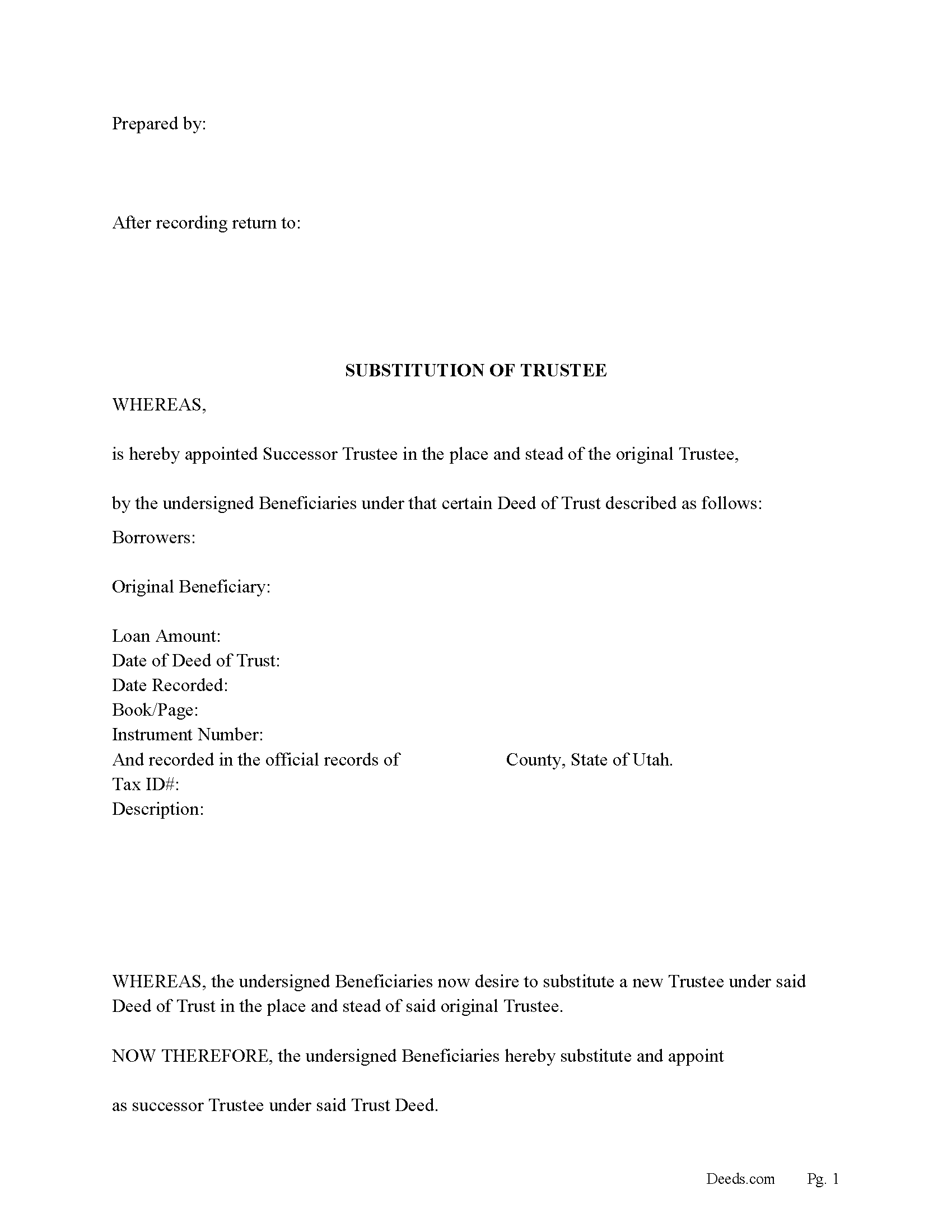
This form is used by the Beneficiary/Lender to appoint a substitute Trustee for a deed of trust.
(The beneficiary may appoint a successor trustee at any time by filing an appointment of trustee or a substitution of trustee for record in the office of the county recorder of each county in which the trust property or a part of the trust property is located.) (Utah Code 57-1-22 (1)(a))
57-1-22. (2) An appointment of trustee or a substitution of trustee shall:
(a) identify the trust deed by stating:
(i) the names of the original parties to the trust deed;
(ii) the date of recordation; and
(iii)(A) the book and page where the trust deed is recorded; or (B) the entry number;
(b) include the legal description of the trust property;
(c) state the name and address of the new trustee; and
(d) be executed and acknowledged by all of the beneficiaries under the trust deed or their successors in interest.
(Utah SOT Package includes form, guidelines, and completed example) For use in Utah only.
... More Information about the Utah Substitute of Trustee for Deed of Trust
Full Reconveyance for Deed of Trust
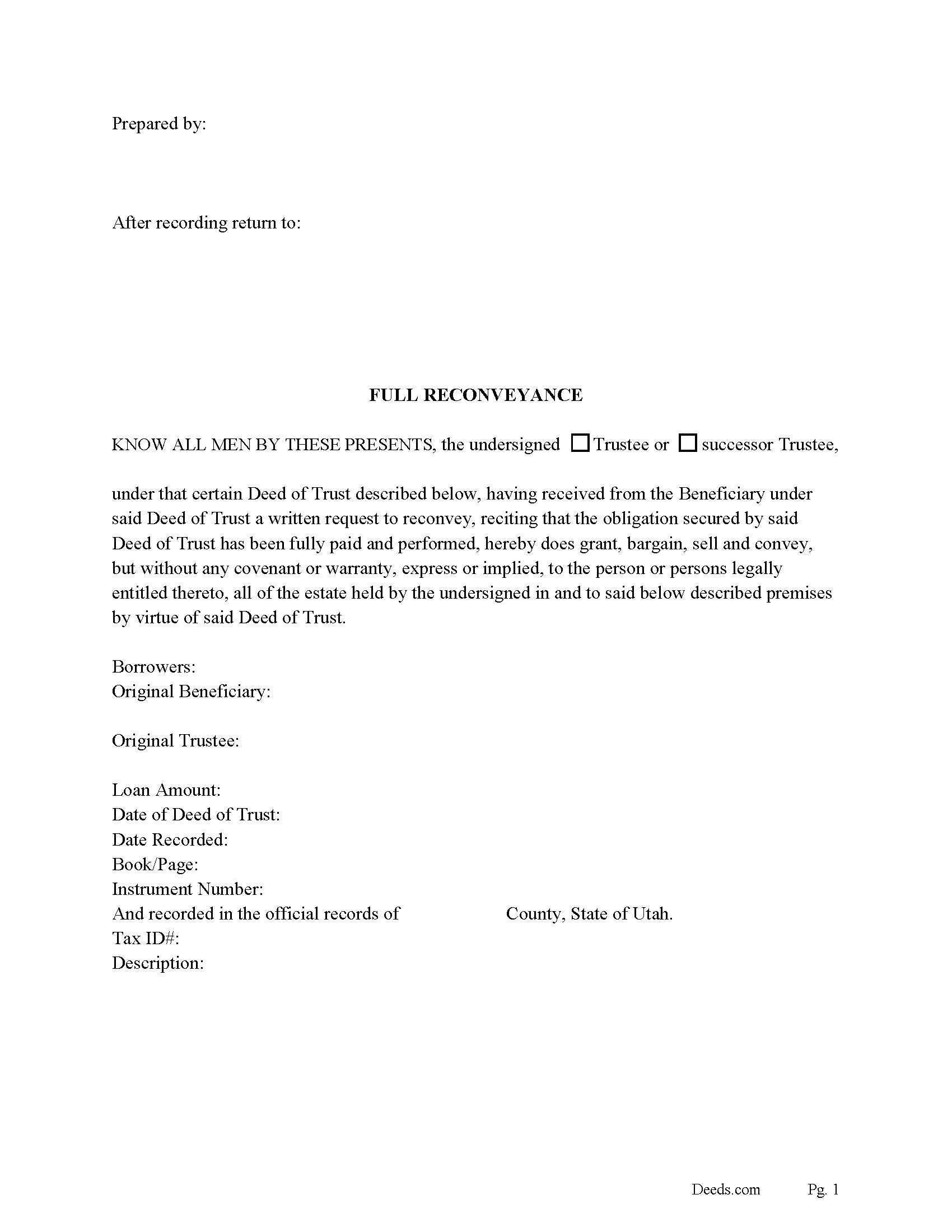
This form is typically used by an Attorney (Utah) or Title Agency when the original Beneficiary/Lender sends a written request for full reconveyance. This form can be used by the original trustee or successor trustee to reconvey but without any covenant or warranty.
(Any trust deed, substitution of trustee, assignment of a beneficial interest under a trust deed, notice of assignment of a beneficial interest, notice of default, trustee's deed, reconveyance of the trust property, and any instrument by which any trust deed is subordinated or waived as to priority, if acknowledged as provided by law, is entitled to be recorded.) (Utah Code 57-1-36)
(Utah Reconveyance Package includes form, guidelines, and completed example) For use in Utah Only.... More Information about the Utah Full Reconveyance for Deed of Trust
Trustee Deed
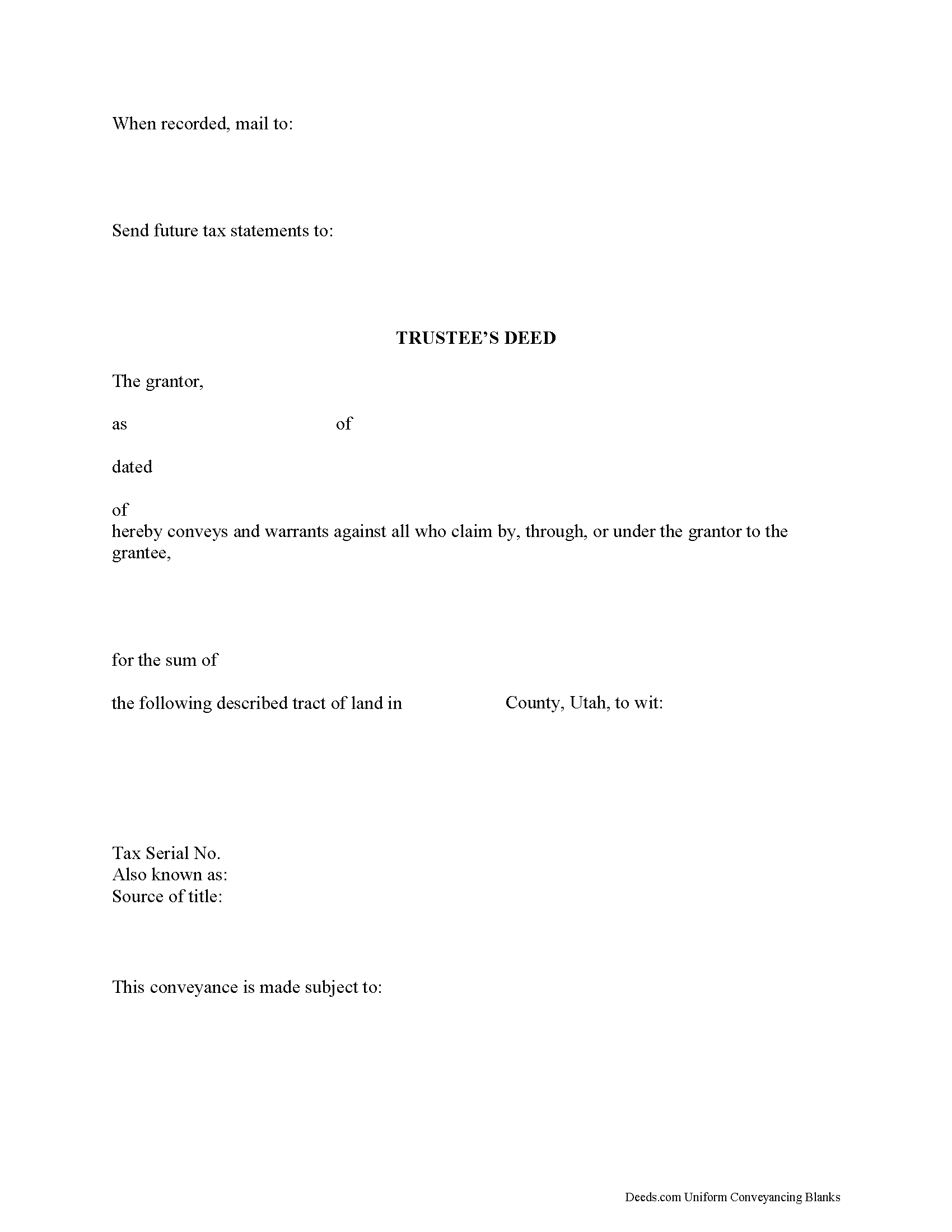
Transferring Real Property to and from Living Trusts in Utah
The Utah Uniform Trust Code, codified at Utah Code 75-7, governs trusts in Utah. A trust is an alternate method of holding title to property. In a trust arrangement, one person (the settlor) transfers property to another (the trustee), who administers the trust for the benefit of a third (the beneficiary). A transfer of property to a trustee during the settlor's lifetime results in a living (inter vivos) trust, and a transfer to a trustee pursuant to the terms of a settlor's will creates a testamentary trust.
A trust is valid only when the settlor has a capacity to create the trust and indicates an intention to do so; the trust has a definite beneficiary; the trustee has duties to perform; and the same person is not both sole trustee and sole beneficiary of the trust ( 75-7-402). The trust must be created for lawful purposes that are possible to achieve and for the benefit its beneficiaries ( 75-7-404).
A living trust is an estate planning tool allowing the settlor to determine how his assets will be distributed without the oversight of the probate court upon his death. The trust is governed by a trust instrumen... More Information about the Utah Trustee Deed
Certificate of Trust
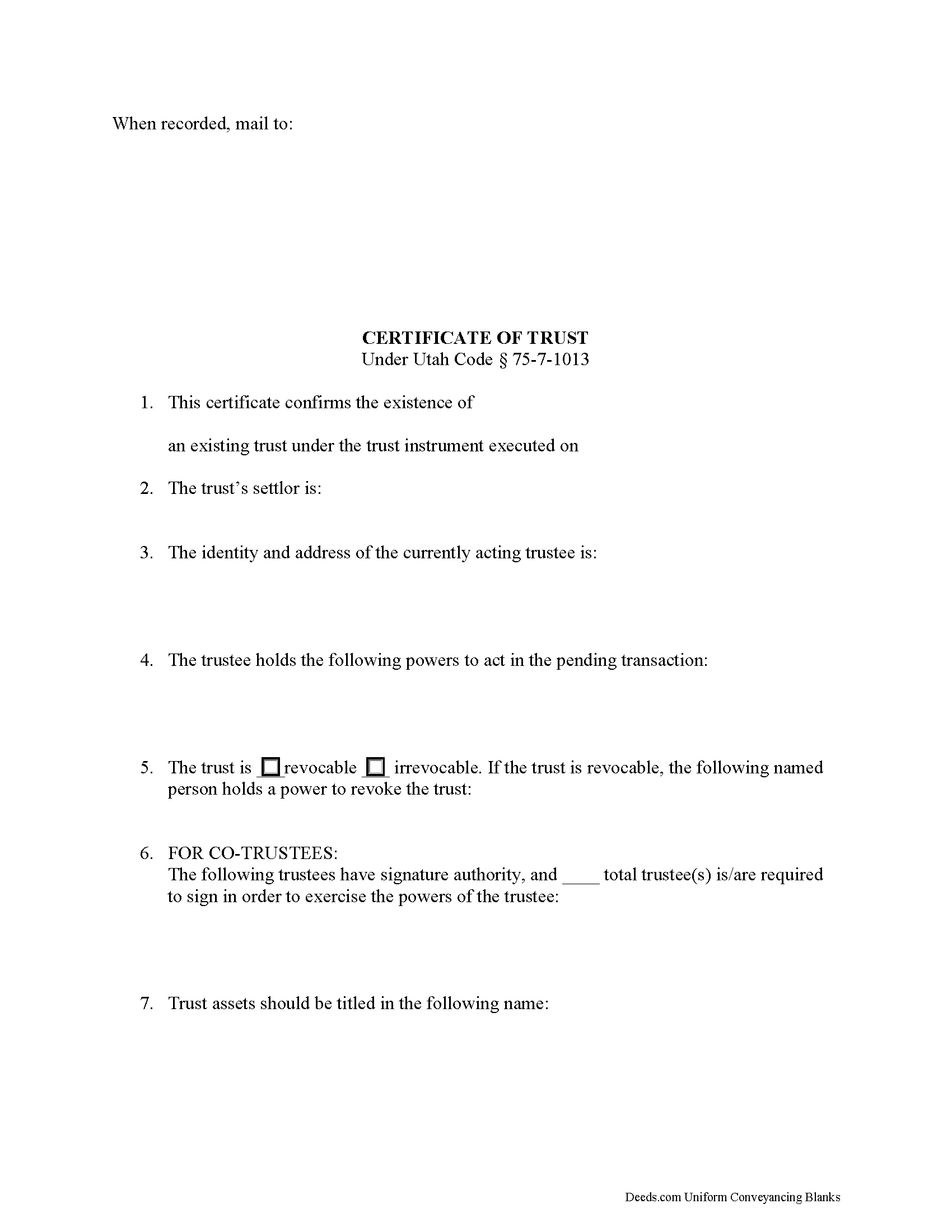
The certification of trust in Utah is codified at Utah Code 75-7-1013 as part of the Utah Uniform Trust Code. Trustees execute this document, which contains certified statements relating to a trust and the trustee's authority to act on the trust's behalf. The document may be recorded (as with acquisitions or transfers of real property) or presented to anyone doing business with a trustee in lieu of the entire trust instrument, which generally remains unrecorded to maintain the settlor's privacy.
The form lists the trust's name and date, the name of each settlor, the name and address of each acting trustee, the powers of the trustee to act in transaction for which the certificate is given, and whether or not the trust is revocable (and who, if anyone, has a power to revoke the trust). The trustee may provide excerpts from the trust instrument in addition to the certificate that designate the trustee and confer the relevant powers onto the trustee. For trusts with multiple trustees, the certificate states how many of the total number is required to join together in order to exercise the trustee's powers and who, specifically, has signing authority. Finally, the document lists the... More Information about the Utah Certificate of Trust
Notice of Completion
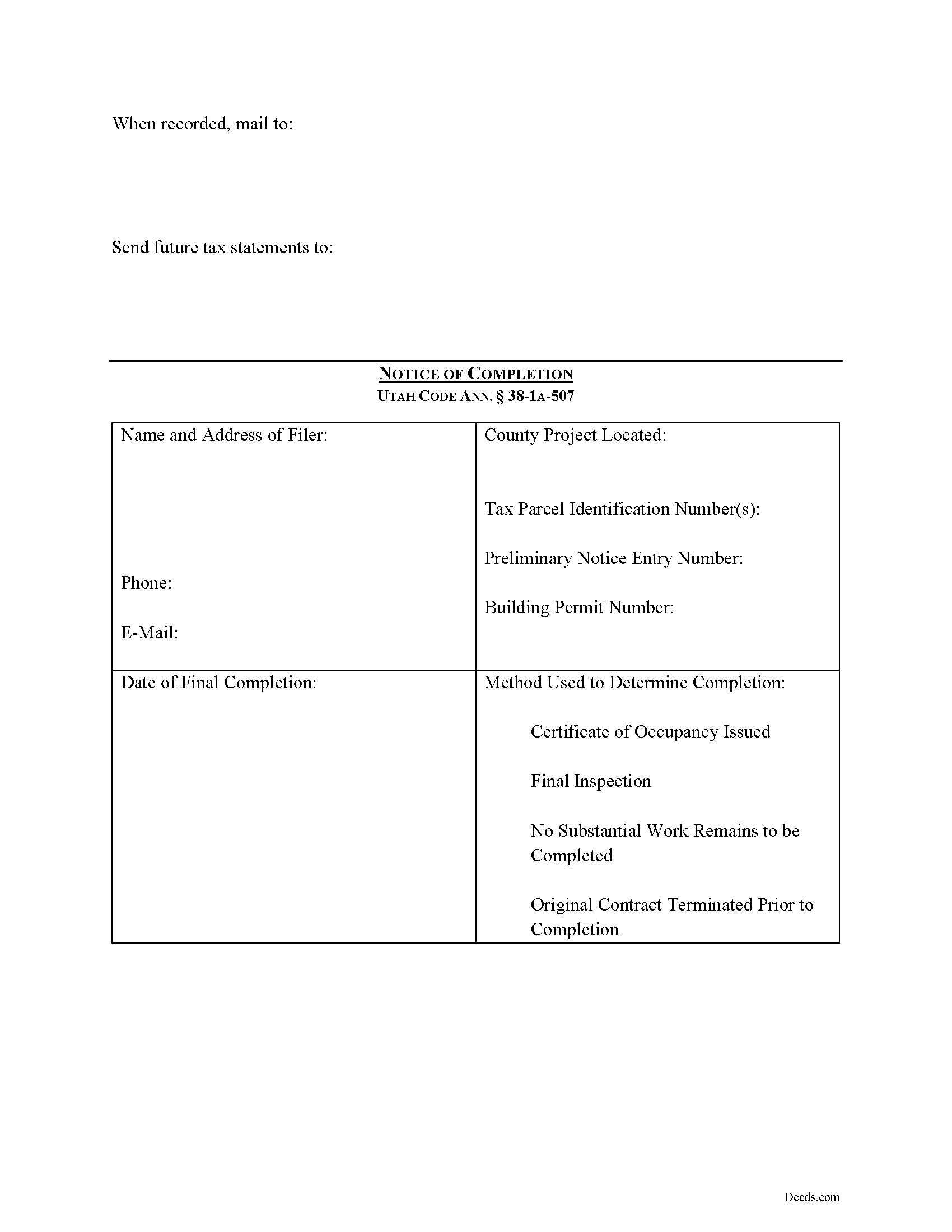
In Utah, mechanic's liens are governed under Title 38, Chapter 1A of the Utah Code.
A Notice of Completion is a document completed by a property owner or other interested party and uploaded the construction registry. Its purpose is to publicize the completion date of a work of improvement on real property which in turn shortens the time during which any potential lien claimant can file for a mechanic's lien against the owner's ownership interest in the estate. Notice must then be provided to all possible claimants who have given the owner notice that they may have lien rights.
Upon final completion of a construction project, a notice of completion may be filed with the registry by: (i) an owner; (ii) an original contractor for construction work; (iii) a lender that has provided financing for the construction project; (iv) a surety that has provided bonding for the construction project; or (v) a title company issuing a title insurance policy on the construction project. UTAH CODE ANN. 38-1A-507(1)(a).
The Notice of Completion document includes the following: (1) the name, address, telephone number, and email address of the person filing the notice of completion; (2) the na... More Information about the Utah Notice of Completion
Preliminary Notice of Lien
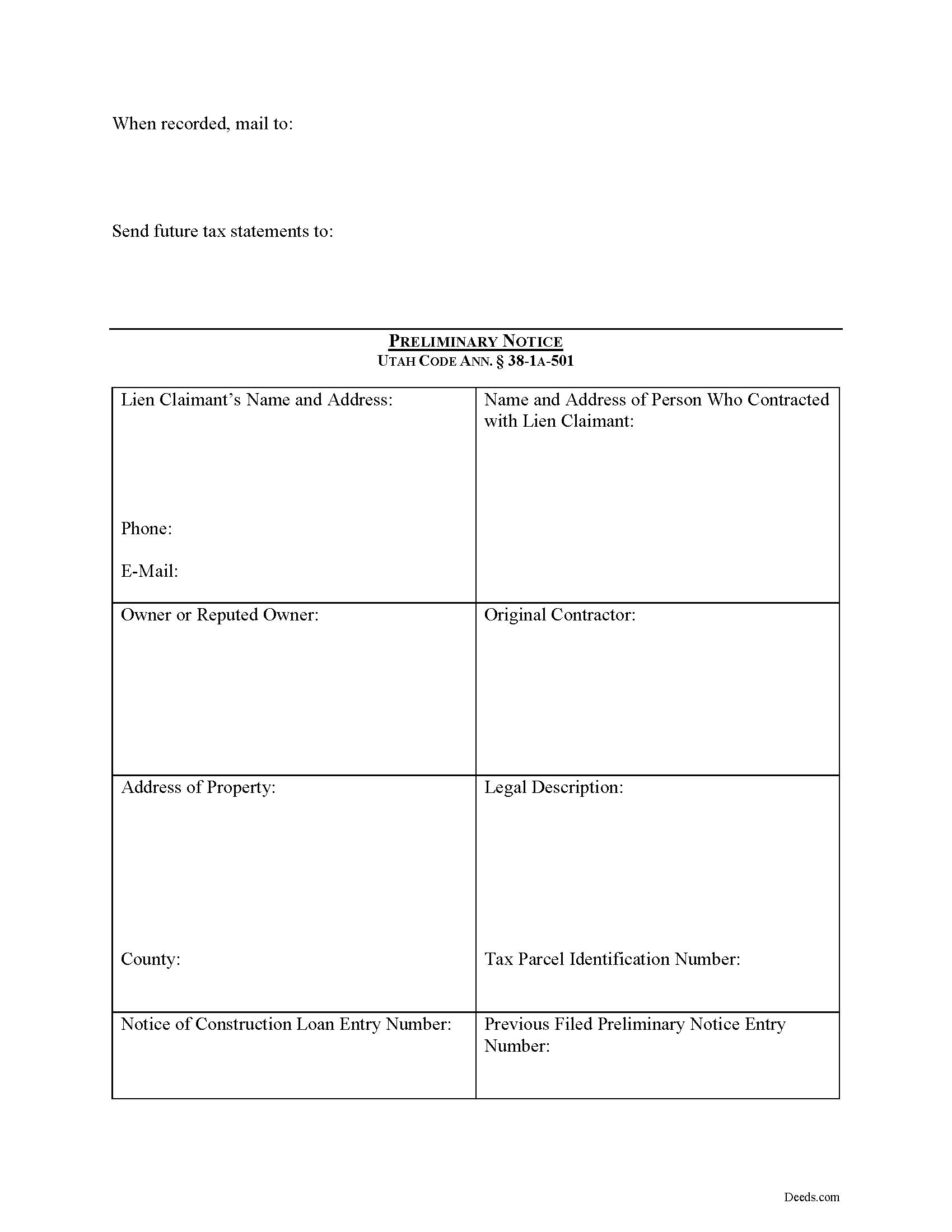
In Utah, mechanic's liens are governed under Title 38, Chapter 1A of the Utah Code.
A preliminary notice is a type of pre-lien notice that must be served on a property owner before any lien can be claimed later on. The notice is a required process under Utah's mechanic's lien law, and failure to comply may result in loss of the potential claimant's right to a mechanic's lien.
Any person who desires to claim a construction lien against real property must file a preliminary notice with the construction registry no later than 20 days after the day on which the person commences providing construction work on the real property. UTAH CODE ANN. 38-1A-501(1)(a). The preliminary notice will then be effective as to all construction work that the person filing the notice provides to the construction project under a single original contract, including construction work that the person provides to more than one supervisory subcontractor under that original contract. 38-1A-501(1)(b).
If a person who desires to claim a construction lien on real property fails to file a timely preliminary notice within the above period specified, he or she may file a preliminary notice with the registry ... More Information about the Utah Preliminary Notice of Lien
Notice of Claim
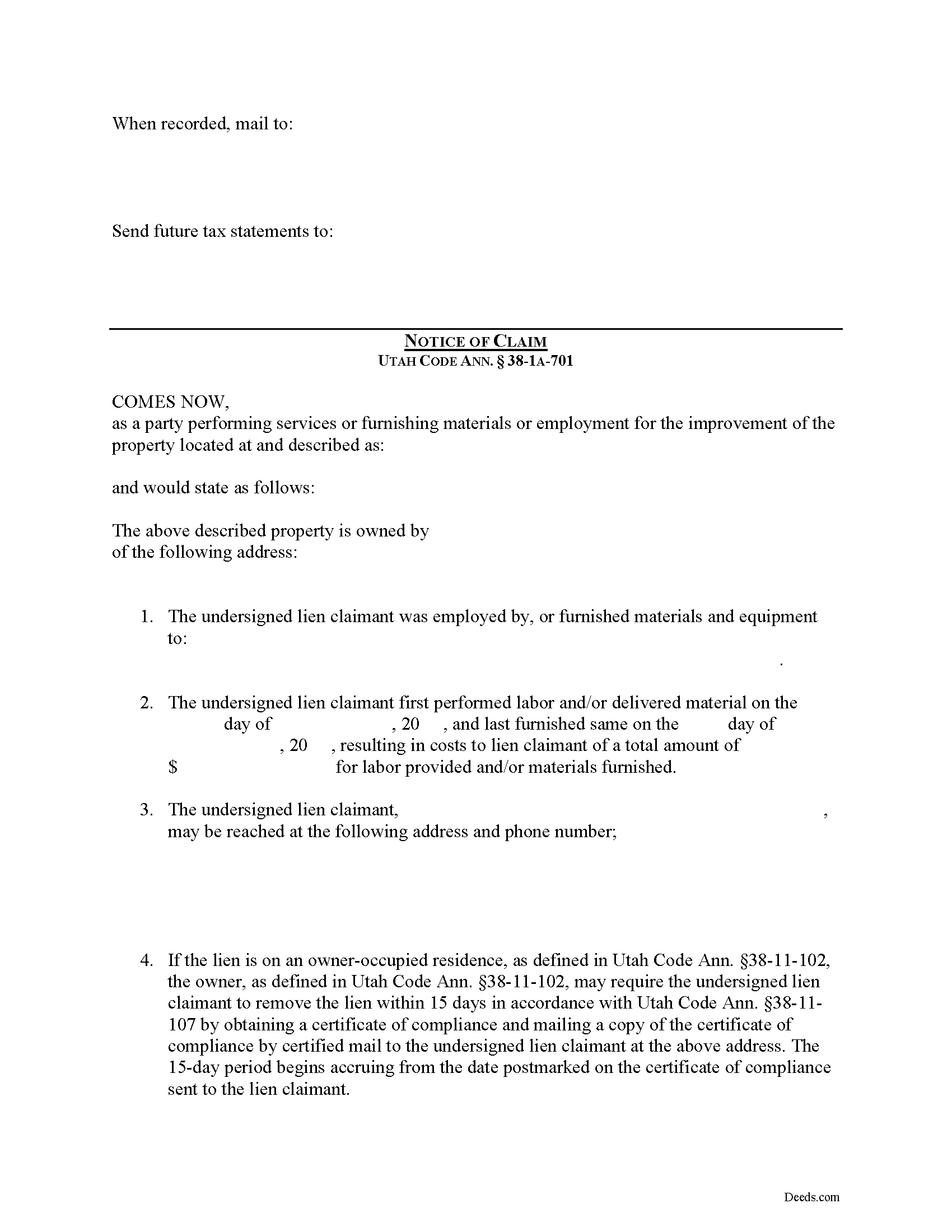
Claiming a Construction Lien in Utah
In Utah, mechanic's liens are governed under Title 38, Chapter 1A of the Utah Code.
Construction liens, also known as mechanic's liens, are used the put a block or burden on an owner's title when construction work or materials delivery has taken place on the owner's property and the person or company providing the work or materials is not paid according to the contract. In Utah, a construction lien means a lien for construction work. Utah Code Ann. 38-1A-102(8). Construction work means labor, service, material, or equipment provided for the purpose and during the process of constructing, altering, or repairing an improvement; and includes scheduling, estimating, staking, supervising, managing, materials testing, inspection, observation, and quality control or assurance involved in constructing, altering, or repairing an improvement. 38-1A-102(11).
To enforce a preconstruction lien or construction lien in Utah, a claimant shall file an action to enforce the lien within 180 days after the day on which the claimant files: (i) a notice of preconstruction lien, for a preconstruction lien; or (ii) a notice of construction lien, for a constru... More Information about the Utah Notice of Claim
Acknowledgment of Satisfaction
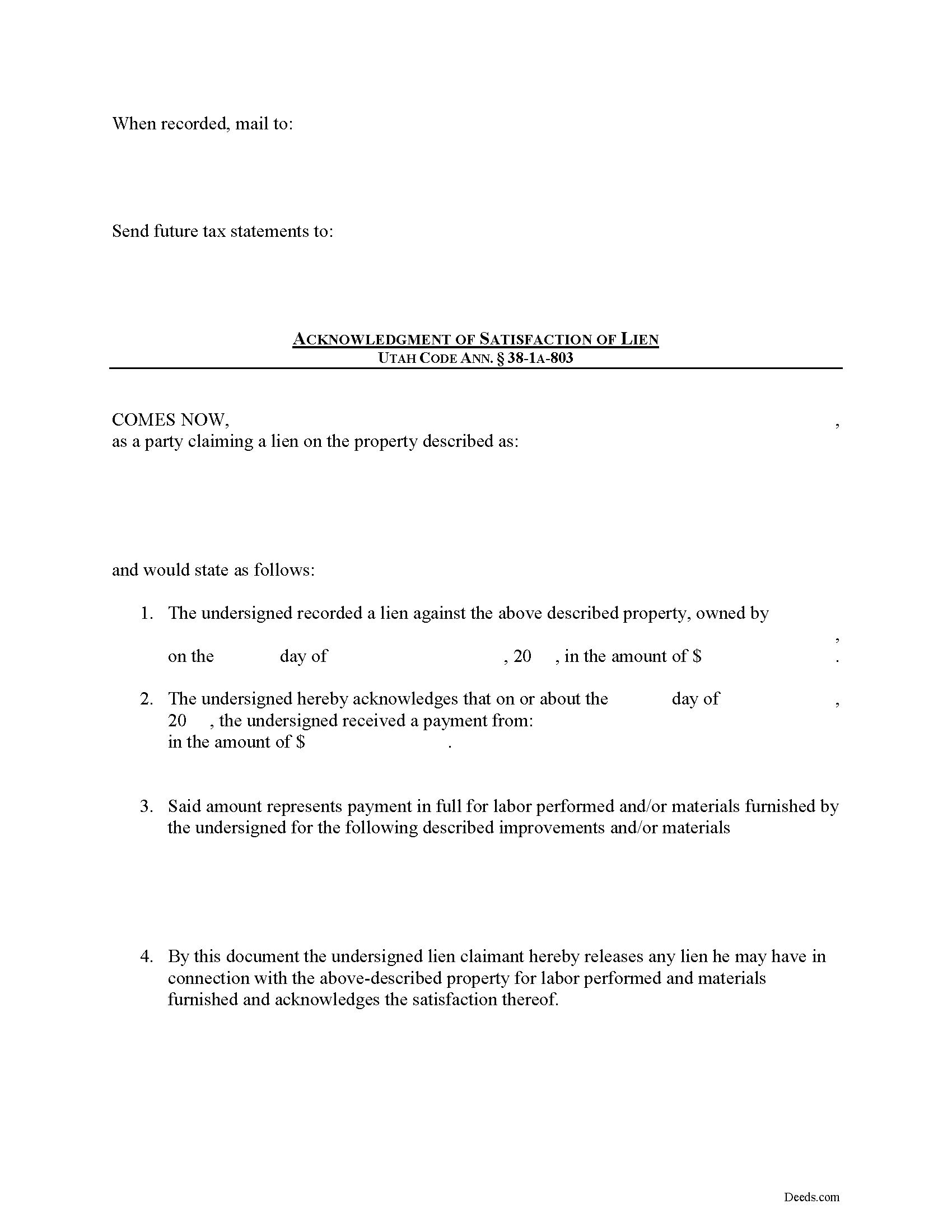
Releasing a Utah Lien after Full Payment with an Acknowledgment of Satisfaction
In Utah, mechanic's liens are governed under Title 38, Chapter 1A of the Utah Code.
Once a construction lien is in place, the owner of the property might be inclined to make a full and final payment in exchange for releasing the lien. After the full amount owed under a preconstruction or construction lien, including costs and cancellation fees, have been paid, a person interested in the property that is the subject of the lien may request the claimant to submit for recording with the office of each applicable county recorder a cancellation of the lien. Utah Code Ann. 38-1A-803(1).
Within 10 days after receiving a request, the claimant shall submit to the office of each applicable county recorder a cancellation of the preconstruction or construction lien, as applicable. Utah Code Ann. 38-1A-803(2). A claimant who fails to submit a cancellation within the time prescribed is liable to the person who requested the cancellation for $100.00 for each day after the time prescribed that the cancellation is not submitted, or the person's actual damages, whichever is greater. Utah Code Ann. 38-1A-803(3).
... More Information about the Utah Acknowledgment of Satisfaction
Complaint for Amount Owed
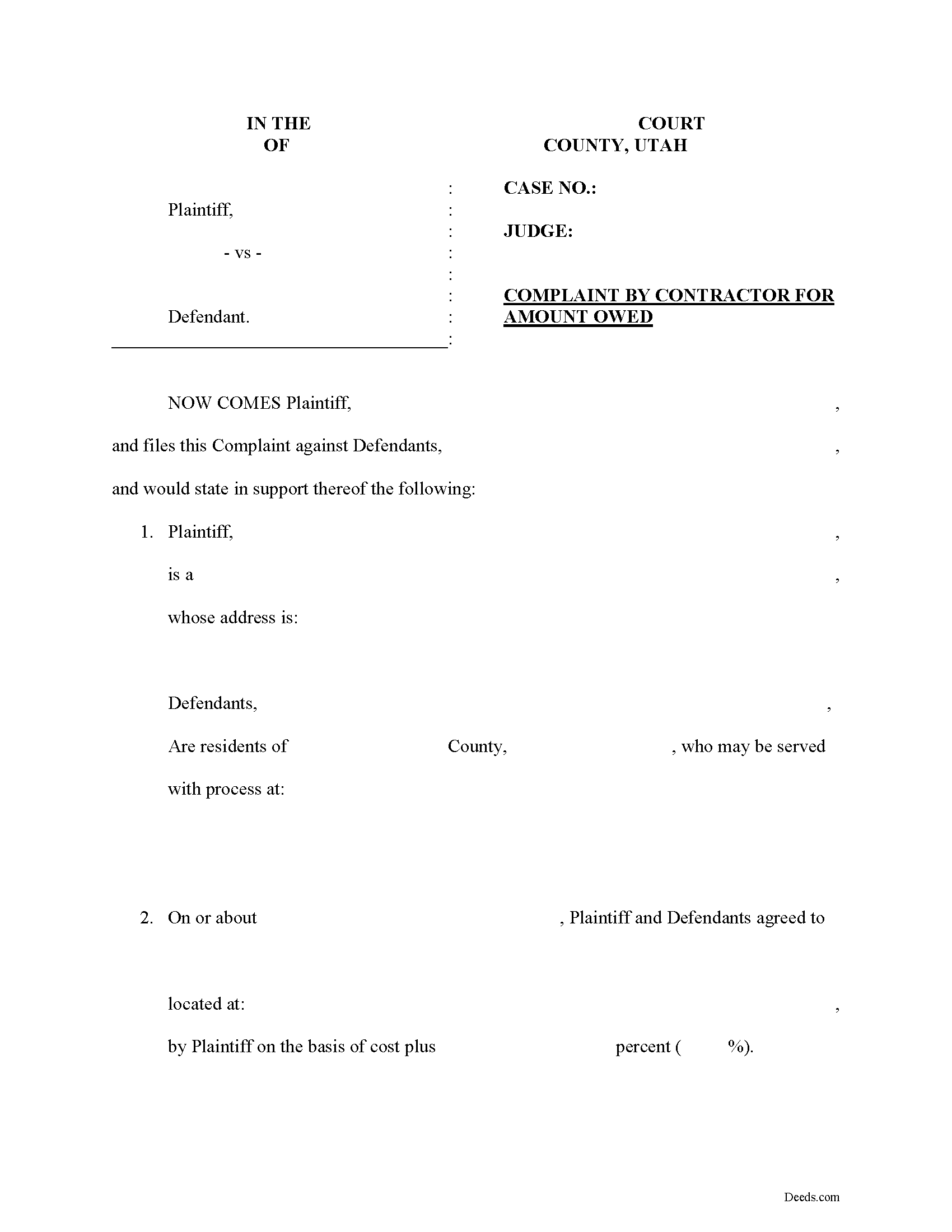
Suing to Enforce a Utah Construction Lien
In Utah, mechanic's liens are governed under Title 38, Chapter 1A of the Utah Code.
Once a construction lien is in place, lien claimants must sue to foreclose on the lien in order liquidate any assets (turn them into cash). The lawsuit is a last resort, used after the claimant has exhausted all other options to induce payment or action on the contract.
Lawsuits are started by filing a complaint. A complaint sets forth the cause of action and specific allegations by way of a short and plain statement outlining the facts that make up the claim (such as a breach of contract, use of services without payment, etc.). It identifies the parties; the location and nature of the work or improvement; relevant dates, fees, and payments; and any other information necessary for the specific case. The complaint also asks the court for the type of relief (usually money but other grounds such as cancelling a contract because the other party failed to live up to their part are acceptable remedies).
Contact an attorney before filing a complaint. View this as money well spent, because lawsuits involve multiple steps, and mistakes could be fatal to ... More Information about the Utah Complaint for Amount Owed
Conditional Lien Waiver on Progress Payment
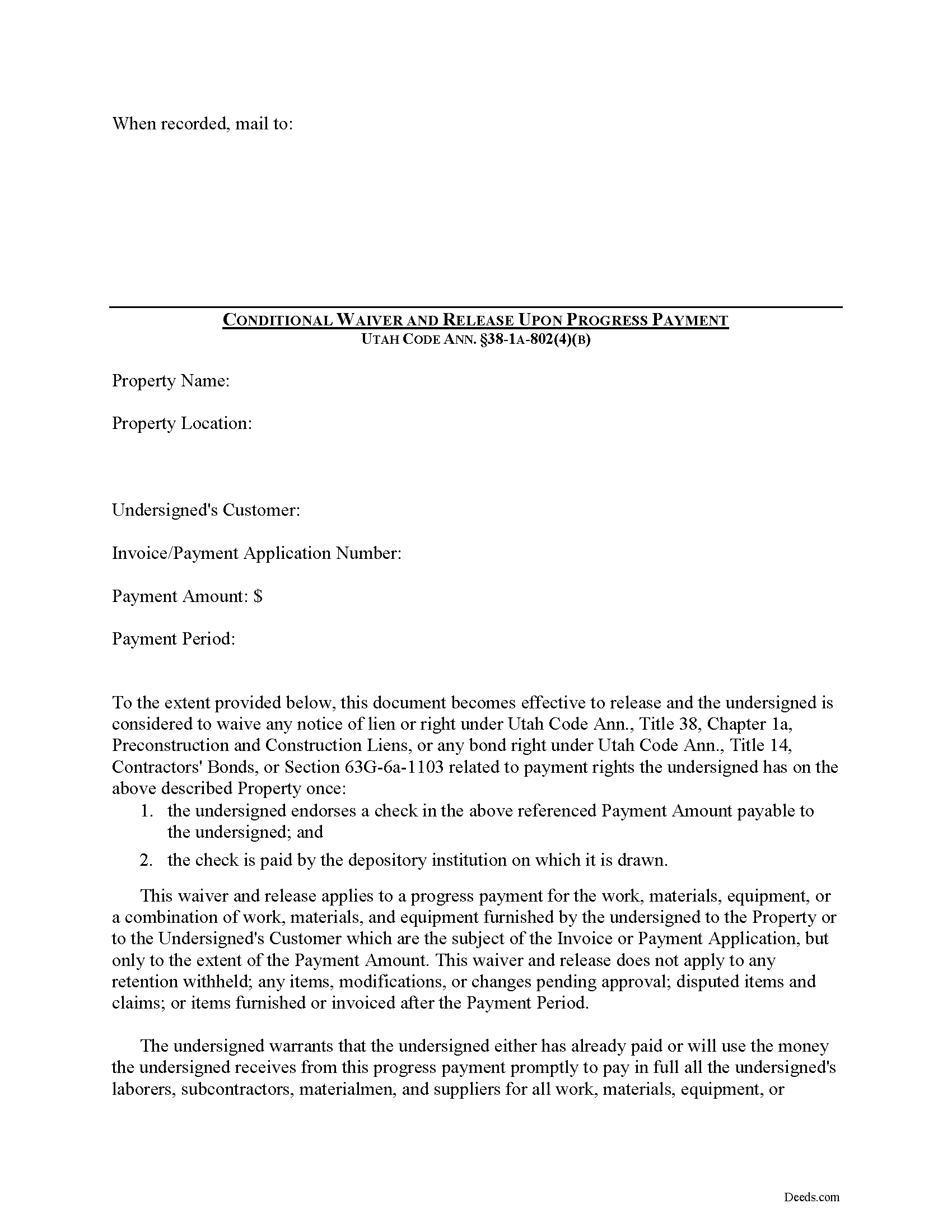
In Utah, mechanic's liens are governed under Title 38, Chapter 1A of the Utah Code.
Throughout the construction process, claimants (eligible contractors) may elect to serve the property owner with a lien waiver in exchange for partial or full payment. Title 38, Chapter 1a, Section 802 sets forth requirements for lien waivers.
The term "waiver" refers to giving up a legal right. In this case, the person granting the waiver is giving up the right to seek a mechanic's lien for all or part of the amount due. This assurance is usually enough to induce the other party to pay. Many states authorize both conditional and unconditional waivers. In Utah, however, if the payment given in exchange for any waiver and release of lien is made by check; and the check fails to clear the depository institution on which it is drawn for any reason, the waiver and release is void. Id. So, in contrast to other states, Utah offers stronger protection for contractors using lien waivers.
A claimant's written consent that waives or limits the claimant's lien rights is enforceable only if the claimant executes a waiver and release that is signed by the claimant or the claimant's authorized agent; or... More Information about the Utah Conditional Lien Waiver on Progress Payment
Waiver and Release on Final Payment
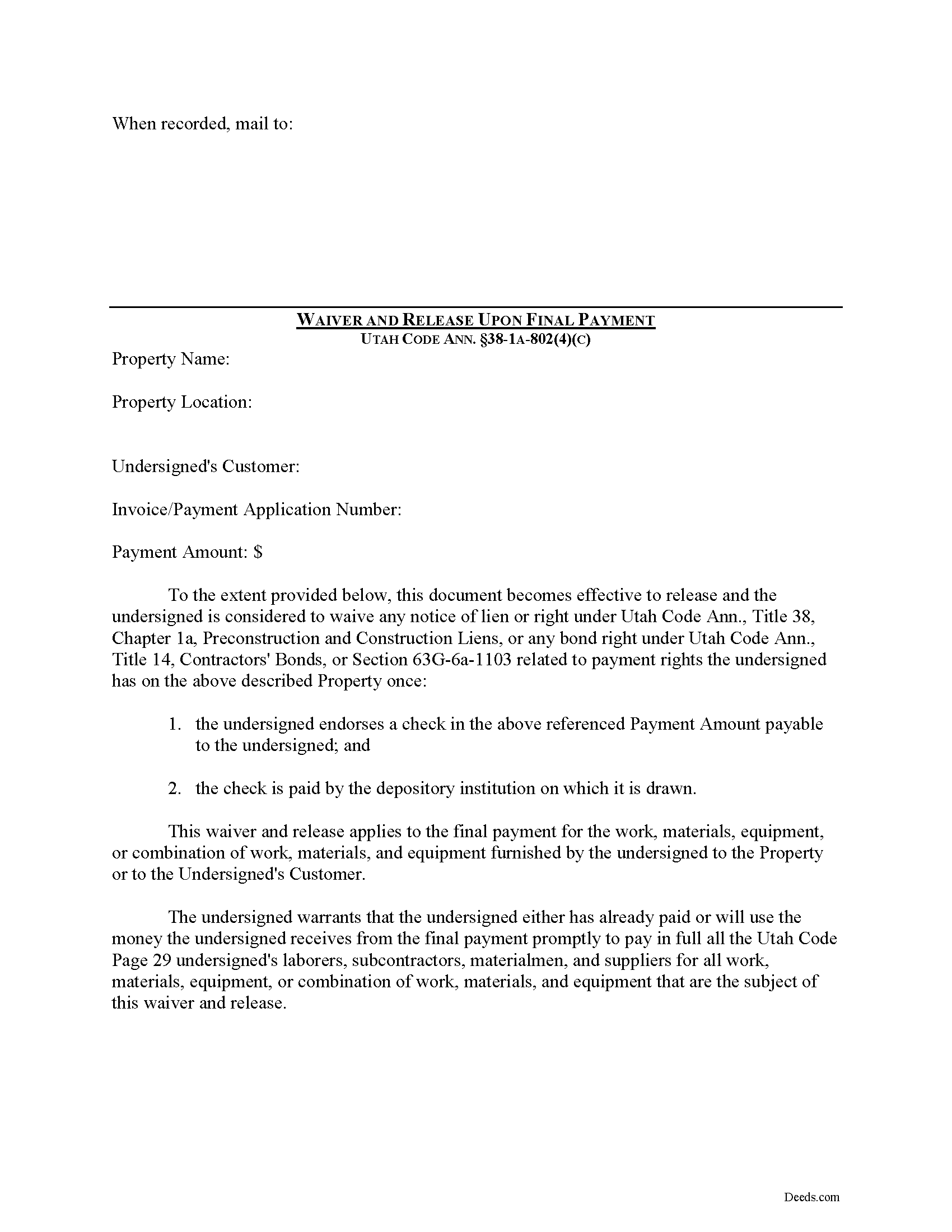
In Utah, mechanic's liens are governed under Title 38, Chapter 1A of the Utah Code. Throughout the construction process, claimants may elect to serve the property owner with a lien waiver in exchange for partial or full payment. Title 38, Chapter 1a, Section 802 sets forth requirements for lien waivers.
The term "waiver" refers to giving up a legal right. In this case, the person granting the waiver is giving up the right to seek a mechanic's lien for all or part of the amount due. This assurance is usually enough to induce the other party to pay. In many states, waivers can be conditional or unconditional. In Utah, however, all lien waivers are conditional, meaning if the payment given in exchange for any waiver and release of lien is made by check; and the check fails to clear the depository institution on which it is drawn for any reason, the waiver and release is void. Id. In contrast to other states, Utah offers stronger protection for contractors using lien waivers.
A claimant's written consent that waives or limits the claimant's lien rights is enforceable only if the claimant executes a waiver and release that is signed by the claimant or an authorized agent; or for a... More Information about the Utah Waiver and Release on Final Payment
Disclaimer of Interest
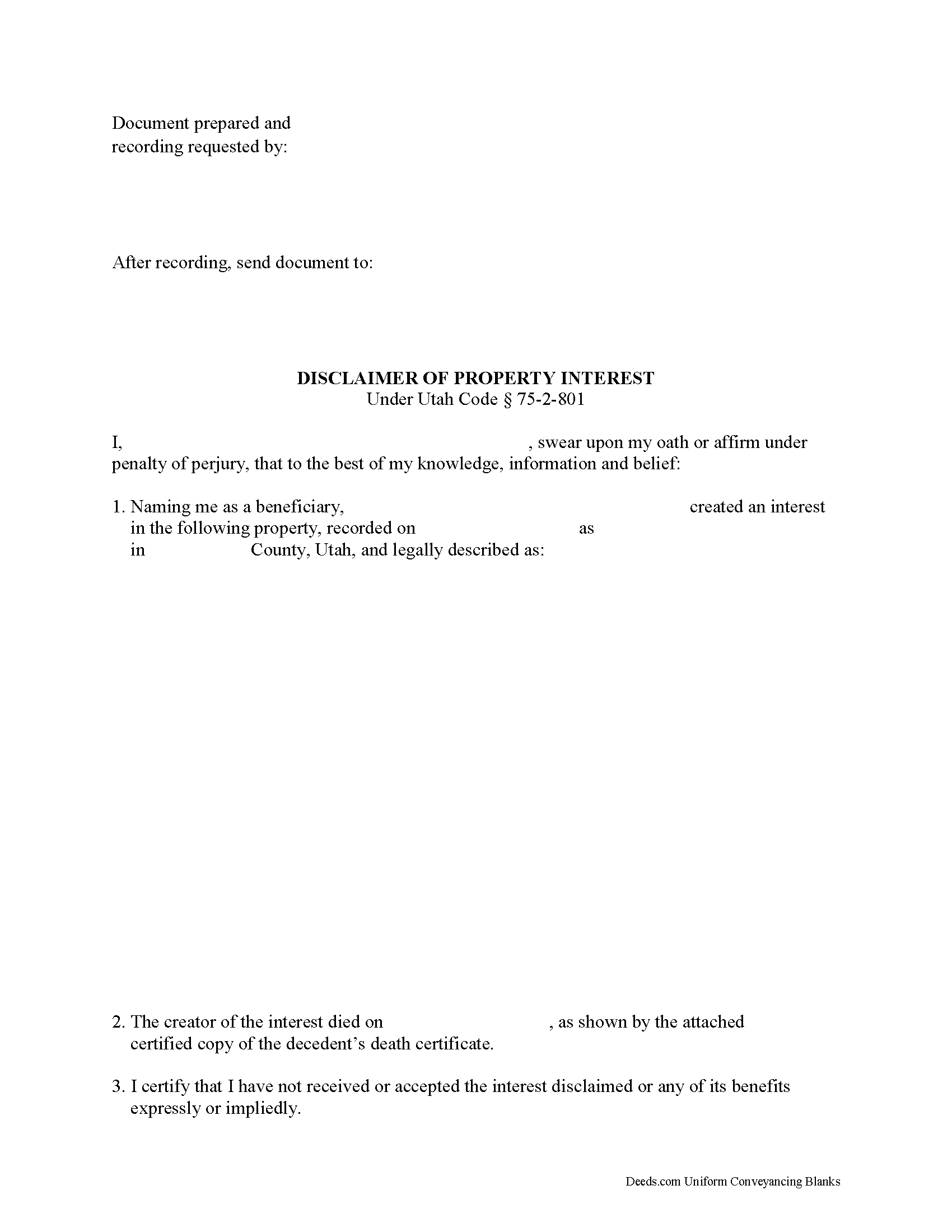
As part of the Utah Uniform Probate Code, the beneficiary of an interest in property may renounce the gift, either in part or in full (Utah Code 75-2-801). Note that the option to disclaim is only available to beneficiaries who have not acted in any way to indicate acceptance or ownership of the interest (Utah Code 75-2-801 (5)).
The disclaimer must be in writing and include a description of the interest, a declaration of intent to disclaim all or a defined portion of the interest, and be signed by the disclaimant (Utah Code 75-2-801 (3)).
File the disclaimer within nine months of the transfer (e.g., the death of the creator of the interest) with the district court of the county that has jurisdiction over proceedings regarding the estate of the deceased donor. In addition, deliver a copy of the disclaimer in person or send it by registered mail to the personal representative of the decedent's estate (Utah Code 75-2-801 (2) (a)). If the transfer is enacted by an instrument other than a will, deliver a copy of the disclaimer to the person who has legal title to or possession of the property (Utah Code 75-2-801 (2) (b)). If real property is involved, record a copy of the... More Information about the Utah Disclaimer of Interest
Mineral Deed
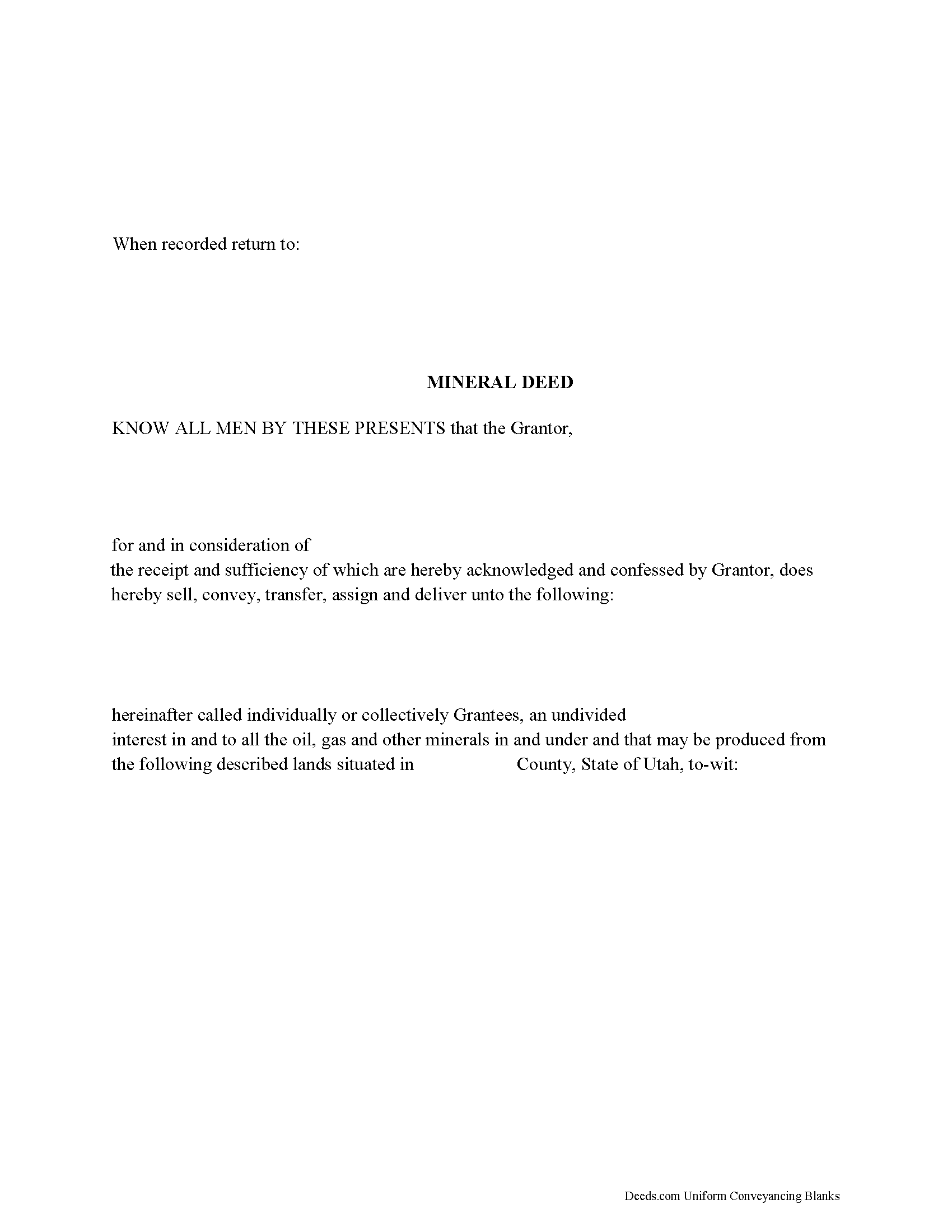
The General Mineral Deed in Utah transfers oil, gas, and mineral rights from the grantor to the grantee. THIS IS NOT A LEASE. There are no Exceptions or Reservations included.
The transfer includes the oil, gas and other minerals of every kind and nature. It also transfers any and all rights to receive royalties, overriding royalties, net profits interests or other payments out of or with respect to those oil, gas and other minerals. The Grantor can stipulate the percentage of Mineral Rights the Grantee will receive and is made subject to any rights existing under any valid and subsisting oil and gas lease or leases of record.
This general mineral deed gives the grantee the right to access, for the purpose of mining, drilling, exploring, operating and developing said lands for oil, gas, and other minerals, and storing handling, transporting and marketing of such.
In this document the Grantor Warrants and will defend said Title to Grantee. Use of this document has a permanent effect on your rights to the property, if you are not completely sure of what you are executing seek the advice of a legal professional.
(Utah MD Package includes form, guidelines, and completed ex... More Information about the Utah Mineral Deed
Mineral Quitclaim Deed
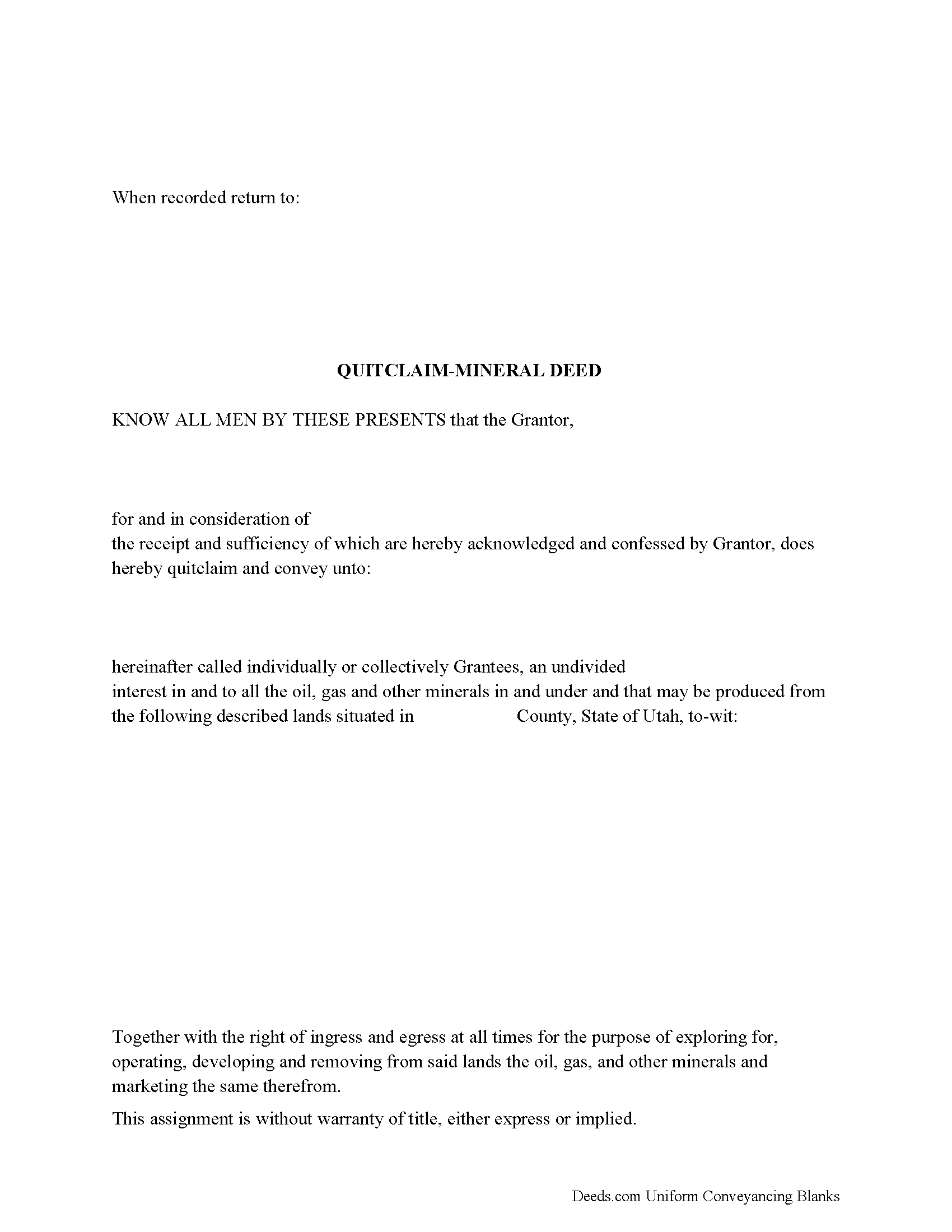
The General Mineral Deed in Utah Quitclaims oil, gas, and mineral rights from the grantor to the grantee. THIS IS NOT A LEASE. There are no Exceptions or Reservations included.
The transfer includes the oil, gas and other minerals of every kind and nature. The Grantor can stipulate the percentage of Mineral Rights the Grantee will receive.
This general mineral deed gives the grantee the right to access, for the purpose of mining, drilling, exploring, operating and developing said lands for oil, gas, and other minerals, and storing handling, transporting and marketing of such.
The seller, or grantor Quitclaims the mineral rights and does NOT accept responsibility to any discrepancy of title (This assignment is without warranty of title, either express or implied)
Uses: Mineral deeds with quitclaim are often used in situations where the grantor wants to quickly release any interest they might have in mineral rights, such as in settling estates, resolving disputes, clearing up uncertainties about ownership in a title's history or when mineral rights have previously been severed or fragmented from surface rights and cloud a title, making it difficult to transfer property. R... More Information about the Utah Mineral Quitclaim Deed
Notice of Lis Pendens
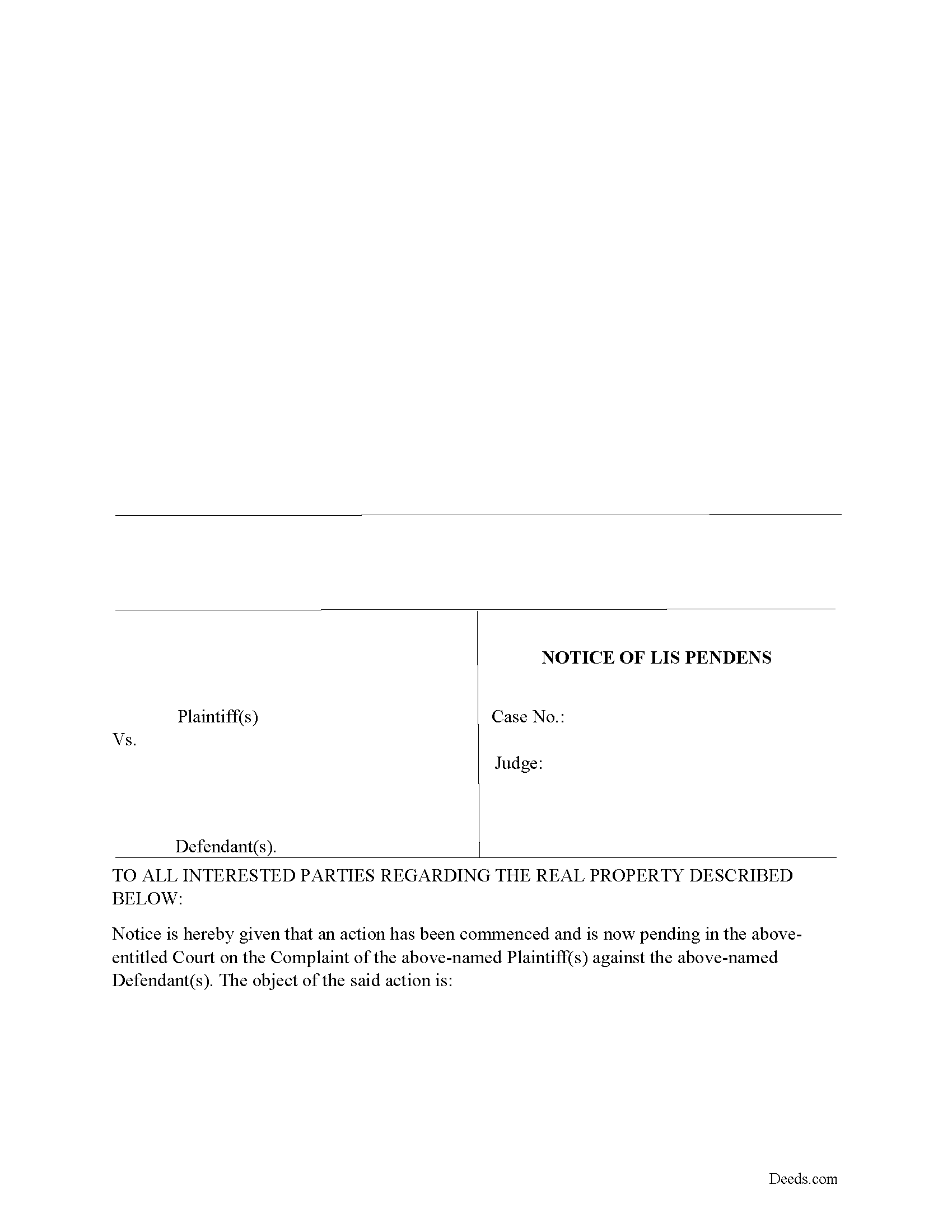
When a complaint affects title to, or right of possession, against real property, then a Lis Pendens must be filed to create constructive notice to would be buyers or encumbrancers, meaning they would be held accountable to the outcome of the case.
A Lis Pendens contains;
The names of the parties involved
The object of the action of the case
A description of the affected property.
(Utah NOLP Package includes form, guidelines, and completed example)
... More Information about the Utah Notice of Lis Pendens
Release of Notice of Lis Pendens
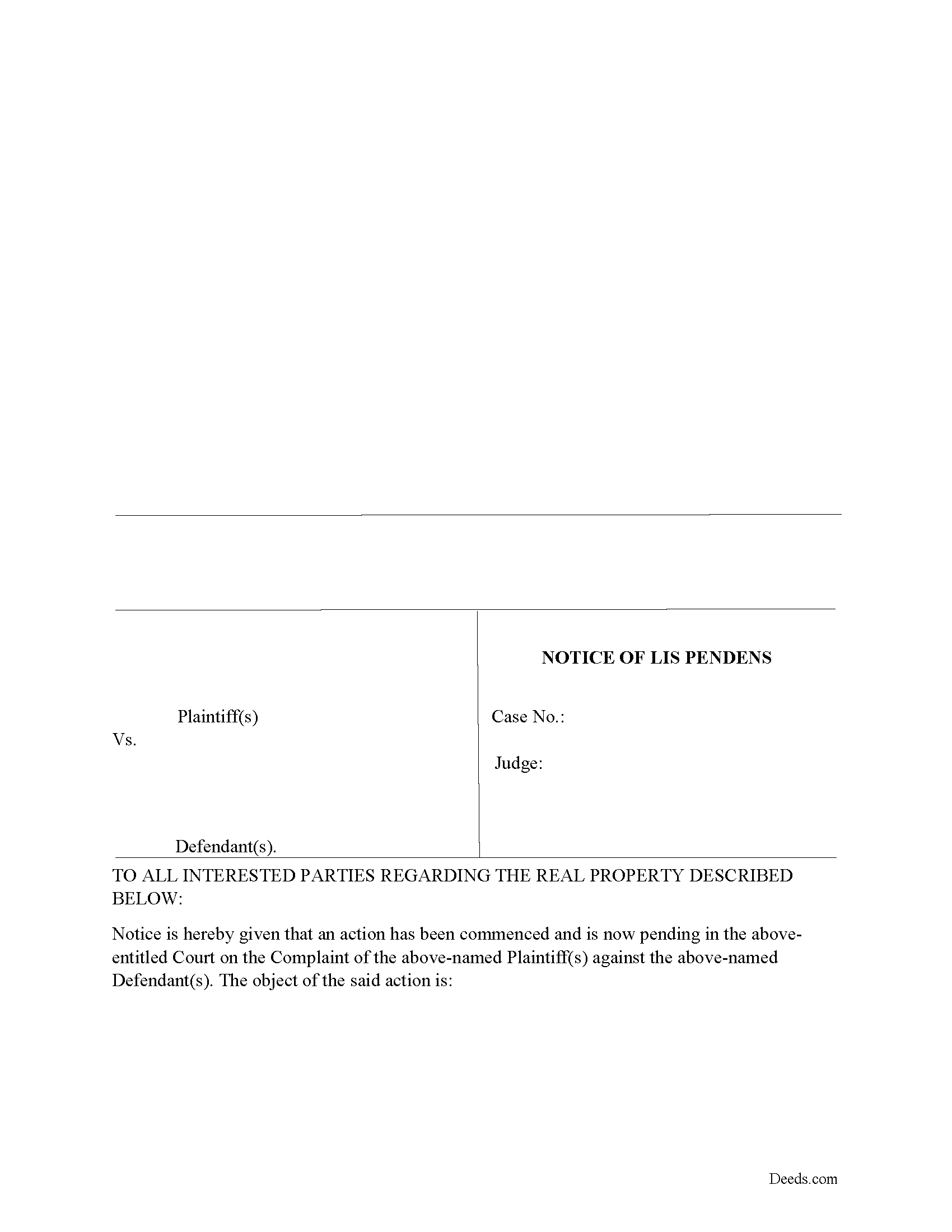
Use this form to release a previously recorded Lis Pendens document.
(Utah Release of NOLP Package includes form, guidelines, and completed example)... More Information about the Utah Release of Notice of Lis Pendens
Special Durable Power of Attorney for the Purchase of Property
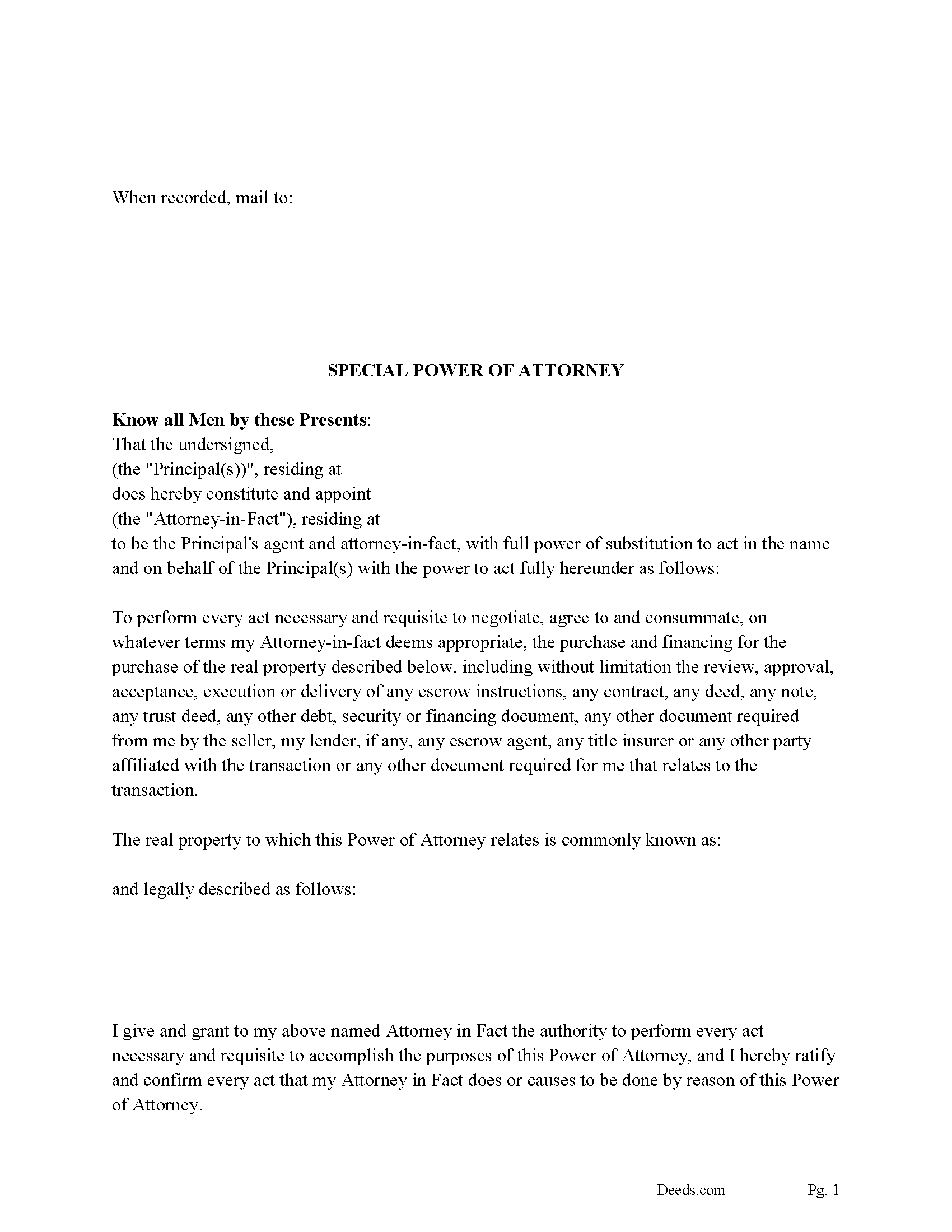
Use this Special Power of Attorney to grant authority (to an agent to act in the place of the principal(s)) as if the principal(s) were present themselves, for the purchase a specific property in Utah. (75-9-102(7))
This power of attorney is durable pursuant to Utah Code 75-9-104 and does not terminate upon the incapacity of the principal(s) It does terminate upon a specific date, that is entered into the form. For Example: This can be used to allow 30, 60, 90 days or more for the purchase to transpire.
75-9-110 Termination of power of attorney or agent's authority.
(d) the power of attorney provides that it terminates;
Governed by laws of the State of Utah.
(Utah SPOA-Purchase Package includes form, guidelines, and completed example)
... More Information about the Utah Special Durable Power of Attorney for the Purchase of Property
Special Durable Power of Attorney for the Sale of Property
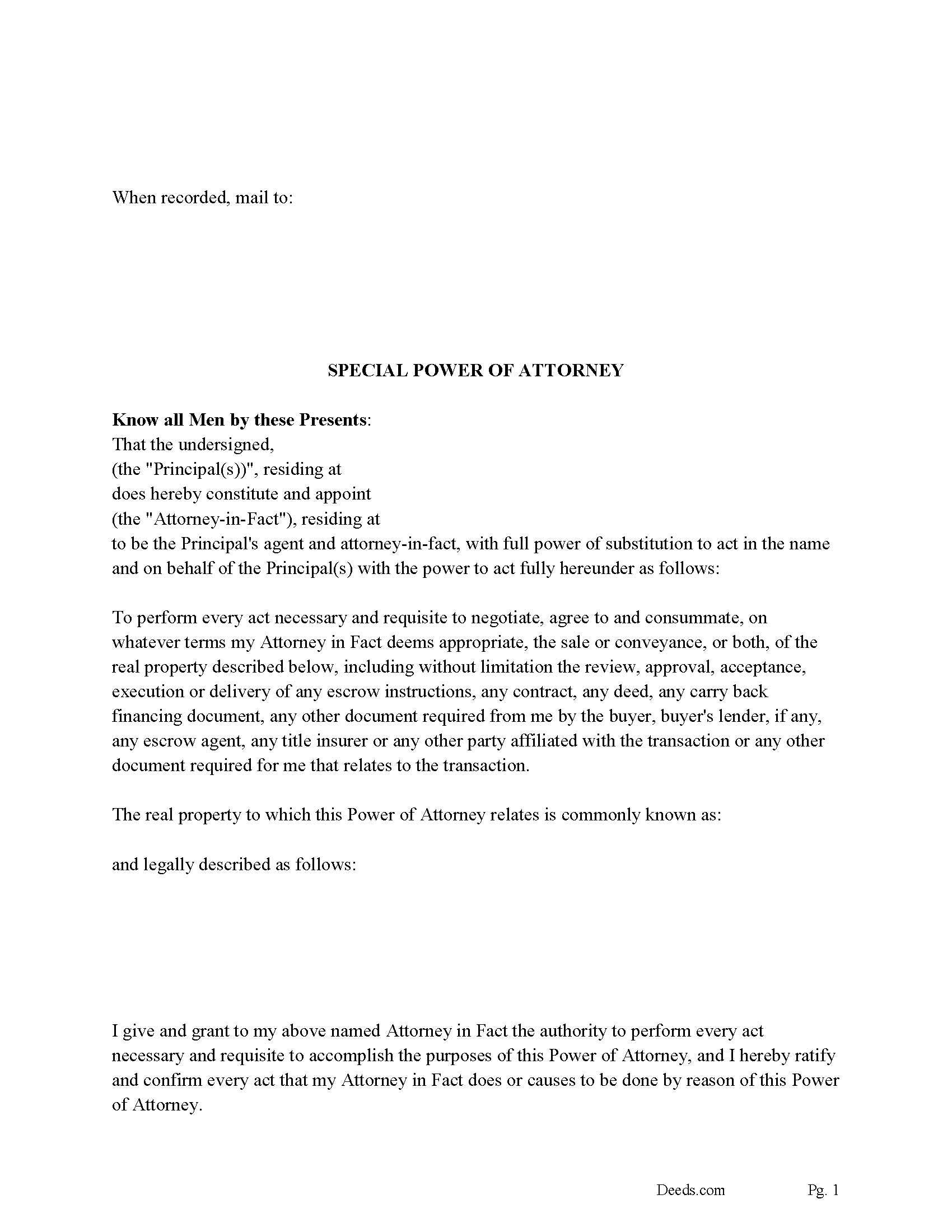
In this form the principal(s), empower(s) an attorney-in-fact to perform every act necessary and requisite to negotiate, agree to and consummate, on whatever terms your Attorney in Fact deems appropriate for the sale or conveyance, or both, of a specific real property.
This power of attorney shall become effective immediately upon the execution of same and pursuant to Utah Code 75-9-104 shall be considered a "Durable Power of Attorney." (ii) shall be governed, as to its validity, terms and enforcement, by those laws of the State of Utah that apply to instruments negotiated, executed, delivered and performed solely within the State of Utah.
Included is a "Special Instructions" section, where the attorney-in-facts powers can be further limited or defined.
(Utah SPOA-Sale Package includes form, guidelines, and completed example)... More Information about the Utah Special Durable Power of Attorney for the Sale of Property